David Simon's Blog, page 8
May 29, 2018
The Place of the Angelic Announcement
Today we changed jobs and moved to a new location in Israel. Part of our dig team is now working at a first century water project in Sippori (more about this tomorrow). We are staying in Nazareth.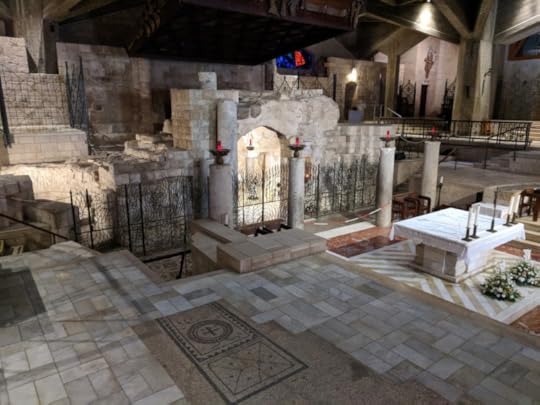 A view of the altar and old house at the Church of the AnnunciationSipori and Nazareth are three to four miles apart. It is thought that Joseph walked from his home in Nazareth to work on a government building project in Sippori. Mark 6:3 and Matthew 13:55 list Joseph as a carpenter (τέκτων, a craftsman, or workman).
A view of the altar and old house at the Church of the AnnunciationSipori and Nazareth are three to four miles apart. It is thought that Joseph walked from his home in Nazareth to work on a government building project in Sippori. Mark 6:3 and Matthew 13:55 list Joseph as a carpenter (τέκτων, a craftsman, or workman).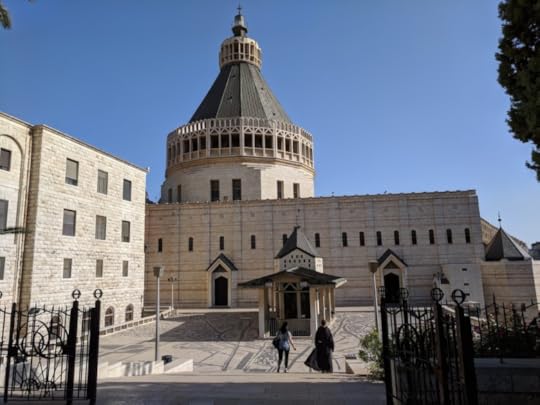 The Church of the Annunciation in NazaretthAll four gospels list Nazareth as the place where Jesus grew up. This is the city where Joseph and Mary lived at the time they were engaged to be married. They lived in this city until the time Jesus became active in ministry and moved to Capernaum.
The Church of the Annunciation in NazaretthAll four gospels list Nazareth as the place where Jesus grew up. This is the city where Joseph and Mary lived at the time they were engaged to be married. They lived in this city until the time Jesus became active in ministry and moved to Capernaum.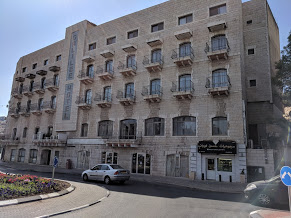 Our hotel in NazarethNazareth was the village where Matthew and Luke report an angel came to Mary with the announcement that she would have a child given by God. The angel also came to Joseph and told him not to divorce his espoused wife for the baby was from God.
Our hotel in NazarethNazareth was the village where Matthew and Luke report an angel came to Mary with the announcement that she would have a child given by God. The angel also came to Joseph and told him not to divorce his espoused wife for the baby was from God.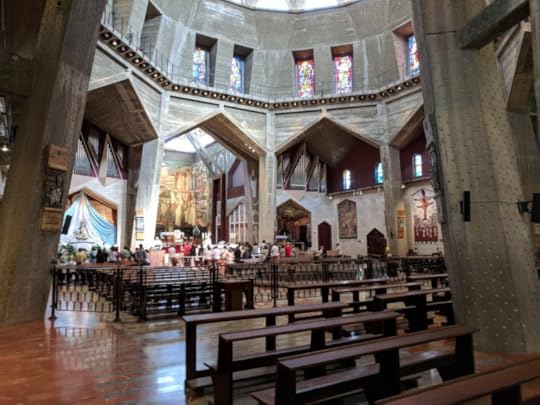 The second floor of the Church of the AnnunciationThe Church of the Annunciation, which was built in Nazareth in the fifth century, celebrates the announcements of the Angel to both Mary and Joseph to tell them of the miraculous birth.
The second floor of the Church of the AnnunciationThe Church of the Annunciation, which was built in Nazareth in the fifth century, celebrates the announcements of the Angel to both Mary and Joseph to tell them of the miraculous birth.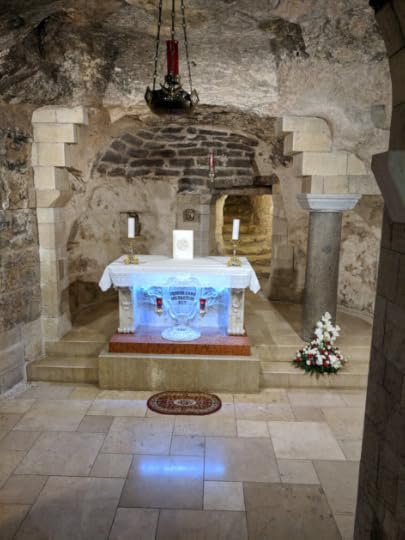 The altar with an old house where Mary livedThe Church of the Annunciation contains what is reputed to be the home of Mary within the building.
The altar with an old house where Mary livedThe Church of the Annunciation contains what is reputed to be the home of Mary within the building.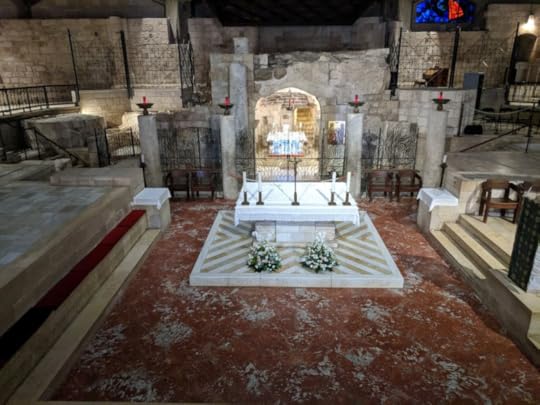 The place of worship at the Church of the AnnunciationThe house sits behind the altar on the first floor of the church, The house, built in ancient times, is impressive to see within the modern church building. One room can be visibly seen with a staircase leading up to a second leve. The house can also be viewed from the second floor of the church where there is a circular opening with a railing around it in middle of the chapel. There was a mass on the second floor, and the choir could be heard during my visit to the chapel on the first floor.
The place of worship at the Church of the AnnunciationThe house sits behind the altar on the first floor of the church, The house, built in ancient times, is impressive to see within the modern church building. One room can be visibly seen with a staircase leading up to a second leve. The house can also be viewed from the second floor of the church where there is a circular opening with a railing around it in middle of the chapel. There was a mass on the second floor, and the choir could be heard during my visit to the chapel on the first floor.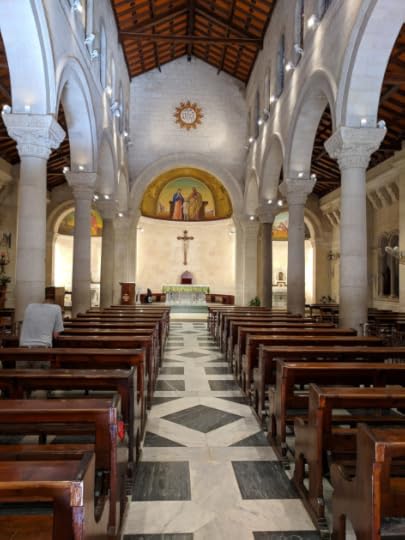 The Church of St. Joseph in NazarethThe Church of St. Joseph sits behind the Church of the Annunciation, and is said to contain ruins of Joseph’s Carpenter shop. Indeed there is a shop with seven steps down, to what is reputed to be a carpenter’s shop.
The Church of St. Joseph in NazarethThe Church of St. Joseph sits behind the Church of the Annunciation, and is said to contain ruins of Joseph’s Carpenter shop. Indeed there is a shop with seven steps down, to what is reputed to be a carpenter’s shop.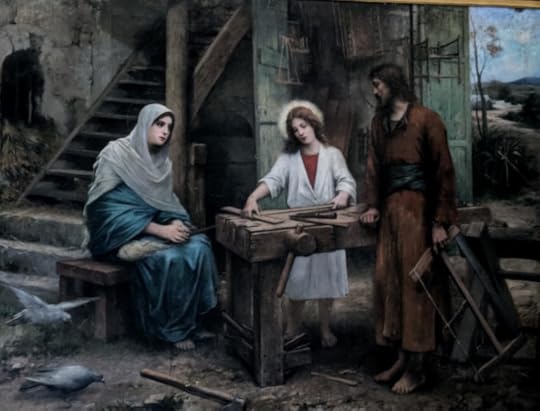 A picture in the church of St. JosephThis is the place where Jesus spent his childhood. He was raised as a normal child and probably served in an apprenticeship to his father.
A picture in the church of St. JosephThis is the place where Jesus spent his childhood. He was raised as a normal child and probably served in an apprenticeship to his father.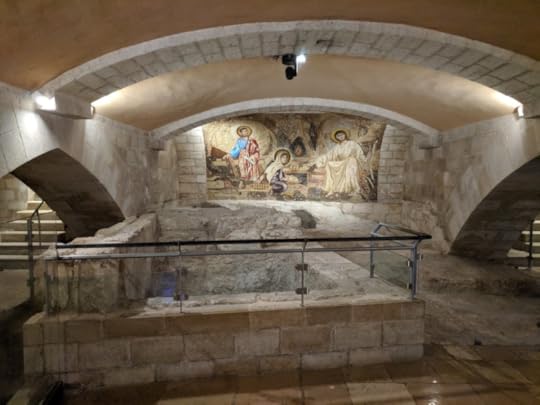 The archeological ruins under the Church of St. JosephThe first several years of Jesus’ career were spent as a carpenter, possibly in Sippori.
The archeological ruins under the Church of St. JosephThe first several years of Jesus’ career were spent as a carpenter, possibly in Sippori.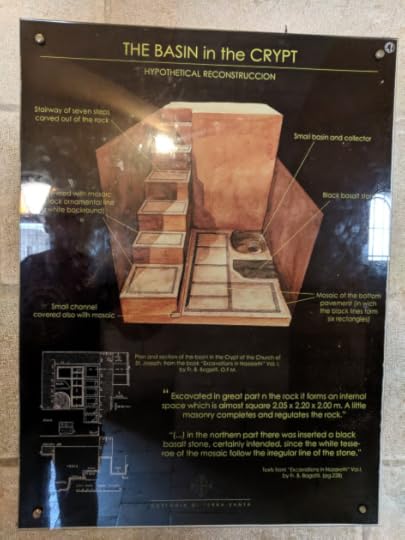 Explaining the Carpenter ShopThere are ruins of what is reported to e the carpentry shop of Joseph in the basement of Joseph’s church. The diagram shows the seven steps down to the shop, the mosaics in the shop and other features. Because of the original rock surface left around the house, one can almost imagine the boy Jesus, playing and working at the site.
Explaining the Carpenter ShopThere are ruins of what is reported to e the carpentry shop of Joseph in the basement of Joseph’s church. The diagram shows the seven steps down to the shop, the mosaics in the shop and other features. Because of the original rock surface left around the house, one can almost imagine the boy Jesus, playing and working at the site.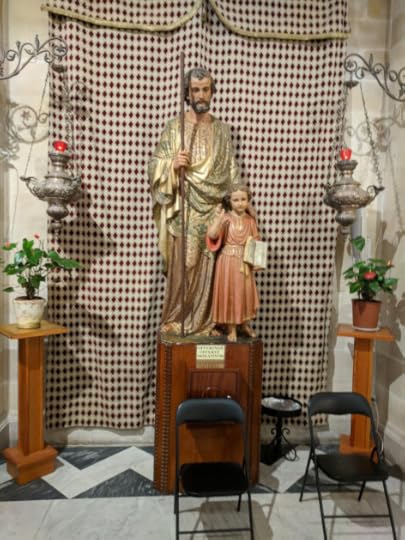 Statue of Joseph and JesusThe churches were not crowded with people when we visited, but the streets were full of people and pigeons.
Statue of Joseph and JesusThe churches were not crowded with people when we visited, but the streets were full of people and pigeons.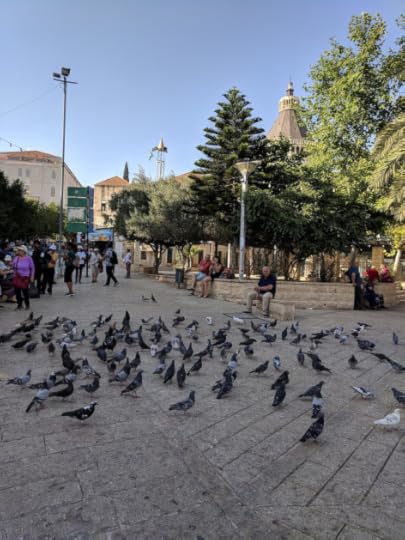 A plaza in Nazareth with the church in view
A plaza in Nazareth with the church in view
The ancient village is now a city which is crowded by people, but within the Church of the Annunciation and the Church of St. Joseph the narrative of this place where Jesus grew from a young boy to a man can still be seen and understood.
 A view of the altar and old house at the Church of the AnnunciationSipori and Nazareth are three to four miles apart. It is thought that Joseph walked from his home in Nazareth to work on a government building project in Sippori. Mark 6:3 and Matthew 13:55 list Joseph as a carpenter (τέκτων, a craftsman, or workman).
A view of the altar and old house at the Church of the AnnunciationSipori and Nazareth are three to four miles apart. It is thought that Joseph walked from his home in Nazareth to work on a government building project in Sippori. Mark 6:3 and Matthew 13:55 list Joseph as a carpenter (τέκτων, a craftsman, or workman). The Church of the Annunciation in NazaretthAll four gospels list Nazareth as the place where Jesus grew up. This is the city where Joseph and Mary lived at the time they were engaged to be married. They lived in this city until the time Jesus became active in ministry and moved to Capernaum.
The Church of the Annunciation in NazaretthAll four gospels list Nazareth as the place where Jesus grew up. This is the city where Joseph and Mary lived at the time they were engaged to be married. They lived in this city until the time Jesus became active in ministry and moved to Capernaum. Our hotel in NazarethNazareth was the village where Matthew and Luke report an angel came to Mary with the announcement that she would have a child given by God. The angel also came to Joseph and told him not to divorce his espoused wife for the baby was from God.
Our hotel in NazarethNazareth was the village where Matthew and Luke report an angel came to Mary with the announcement that she would have a child given by God. The angel also came to Joseph and told him not to divorce his espoused wife for the baby was from God. The second floor of the Church of the AnnunciationThe Church of the Annunciation, which was built in Nazareth in the fifth century, celebrates the announcements of the Angel to both Mary and Joseph to tell them of the miraculous birth.
The second floor of the Church of the AnnunciationThe Church of the Annunciation, which was built in Nazareth in the fifth century, celebrates the announcements of the Angel to both Mary and Joseph to tell them of the miraculous birth. The altar with an old house where Mary livedThe Church of the Annunciation contains what is reputed to be the home of Mary within the building.
The altar with an old house where Mary livedThe Church of the Annunciation contains what is reputed to be the home of Mary within the building. The place of worship at the Church of the AnnunciationThe house sits behind the altar on the first floor of the church, The house, built in ancient times, is impressive to see within the modern church building. One room can be visibly seen with a staircase leading up to a second leve. The house can also be viewed from the second floor of the church where there is a circular opening with a railing around it in middle of the chapel. There was a mass on the second floor, and the choir could be heard during my visit to the chapel on the first floor.
The place of worship at the Church of the AnnunciationThe house sits behind the altar on the first floor of the church, The house, built in ancient times, is impressive to see within the modern church building. One room can be visibly seen with a staircase leading up to a second leve. The house can also be viewed from the second floor of the church where there is a circular opening with a railing around it in middle of the chapel. There was a mass on the second floor, and the choir could be heard during my visit to the chapel on the first floor. The Church of St. Joseph in NazarethThe Church of St. Joseph sits behind the Church of the Annunciation, and is said to contain ruins of Joseph’s Carpenter shop. Indeed there is a shop with seven steps down, to what is reputed to be a carpenter’s shop.
The Church of St. Joseph in NazarethThe Church of St. Joseph sits behind the Church of the Annunciation, and is said to contain ruins of Joseph’s Carpenter shop. Indeed there is a shop with seven steps down, to what is reputed to be a carpenter’s shop. A picture in the church of St. JosephThis is the place where Jesus spent his childhood. He was raised as a normal child and probably served in an apprenticeship to his father.
A picture in the church of St. JosephThis is the place where Jesus spent his childhood. He was raised as a normal child and probably served in an apprenticeship to his father. The archeological ruins under the Church of St. JosephThe first several years of Jesus’ career were spent as a carpenter, possibly in Sippori.
The archeological ruins under the Church of St. JosephThe first several years of Jesus’ career were spent as a carpenter, possibly in Sippori. Explaining the Carpenter ShopThere are ruins of what is reported to e the carpentry shop of Joseph in the basement of Joseph’s church. The diagram shows the seven steps down to the shop, the mosaics in the shop and other features. Because of the original rock surface left around the house, one can almost imagine the boy Jesus, playing and working at the site.
Explaining the Carpenter ShopThere are ruins of what is reported to e the carpentry shop of Joseph in the basement of Joseph’s church. The diagram shows the seven steps down to the shop, the mosaics in the shop and other features. Because of the original rock surface left around the house, one can almost imagine the boy Jesus, playing and working at the site. Statue of Joseph and JesusThe churches were not crowded with people when we visited, but the streets were full of people and pigeons.
Statue of Joseph and JesusThe churches were not crowded with people when we visited, but the streets were full of people and pigeons. A plaza in Nazareth with the church in view
A plaza in Nazareth with the church in viewThe ancient village is now a city which is crowded by people, but within the Church of the Annunciation and the Church of St. Joseph the narrative of this place where Jesus grew from a young boy to a man can still be seen and understood.
Published on May 29, 2018 19:39
May 28, 2018
Working in a Cave
Yesterday we began our dig at Gezer, a major archeological site going back to the Bronze Age and earlier.
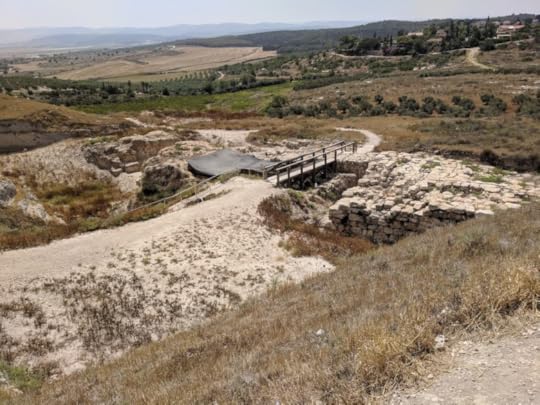 Canaanite area at Tel Gezer. Canaanite house under tarp, Gate to left, the tower is to the right of the bridge.We are working in an area which that was developed during the Canaanite period.
Canaanite area at Tel Gezer. Canaanite house under tarp, Gate to left, the tower is to the right of the bridge.We are working in an area which that was developed during the Canaanite period.
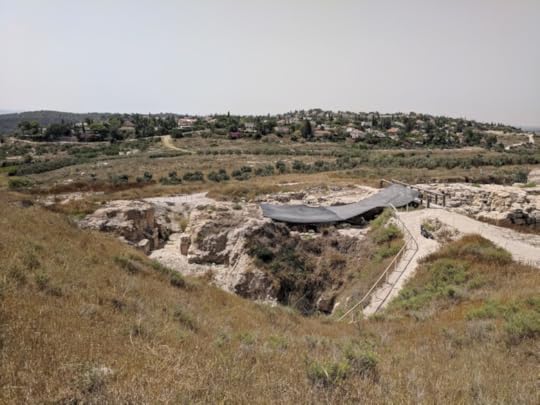 The water project is the large hole in frontDr. Warner, who has been working at Gezer for more than a dozen summers walked us around the site pointing out different areas. He pointed out various features of the site. One area was the Canaanite Gate with its massive entrance and mud bricks.
The water project is the large hole in frontDr. Warner, who has been working at Gezer for more than a dozen summers walked us around the site pointing out different areas. He pointed out various features of the site. One area was the Canaanite Gate with its massive entrance and mud bricks.
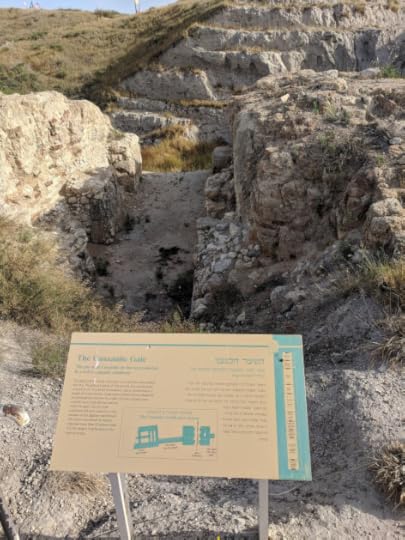 The Canaanite Gate at GezerAnother area he highlighted was a massive tower for the protection of the city. The base of the tower is at least 45’ by 55’ in area. The tower probably stood 40’ tall with an additional mud brick structure above that.
The Canaanite Gate at GezerAnother area he highlighted was a massive tower for the protection of the city. The base of the tower is at least 45’ by 55’ in area. The tower probably stood 40’ tall with an additional mud brick structure above that.
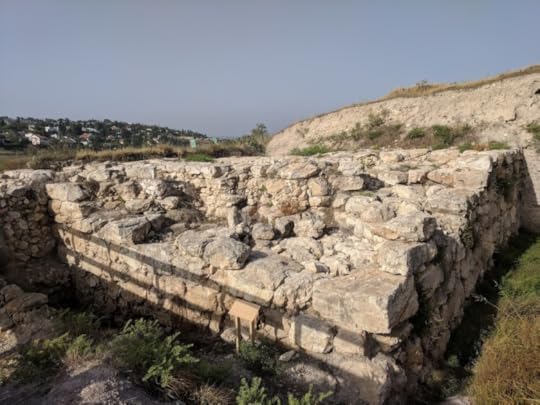 The remains of the huge tower at GezerDuring a 150 year period of peace, the Canaanite cities launched aggressive building programs. City walls became massive, with large gates and watchtowers. Other projects were also undertaken.
The remains of the huge tower at GezerDuring a 150 year period of peace, the Canaanite cities launched aggressive building programs. City walls became massive, with large gates and watchtowers. Other projects were also undertaken.
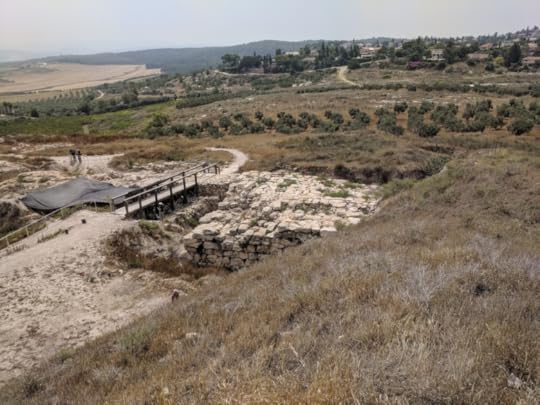 Canaanite Tower from above
Canaanite Tower from above
One of these was the huge water project.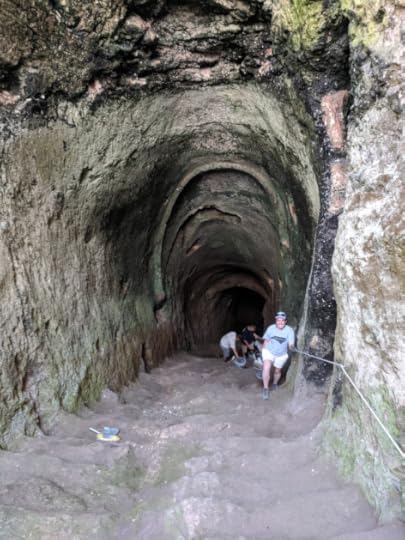 The inside of the tunnel with hand carved arches aboveThe hand carved tunnel goes 180 feet under the ground, and then laterally.
The inside of the tunnel with hand carved arches aboveThe hand carved tunnel goes 180 feet under the ground, and then laterally. 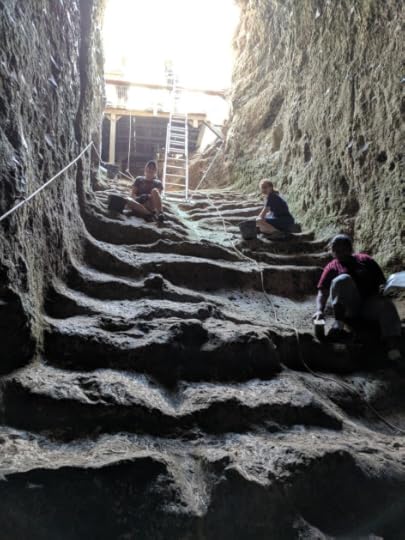 The team cleaning the steps of the TunnelMy project the first two days is to clean steps. After 4,000 years without maid service, needless to say, they are a bit dirty. The pigeons and bats who live in the cave also leave reminders of their presence.
The team cleaning the steps of the TunnelMy project the first two days is to clean steps. After 4,000 years without maid service, needless to say, they are a bit dirty. The pigeons and bats who live in the cave also leave reminders of their presence.
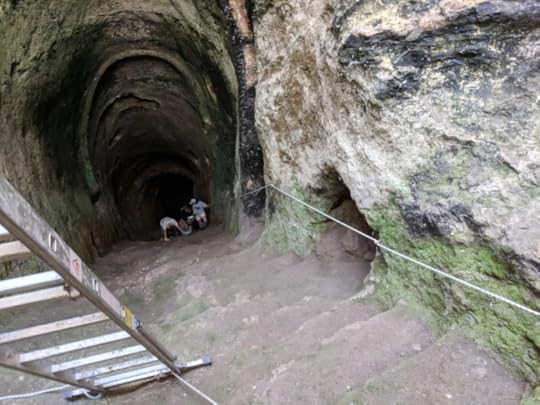 Safety features included the ladder and the hand ropeAs we cleaned the steps, we learned that various critters live in the cave. We heard the singing of pigeons, who fluttered in and out of the cave. We met some of their offspring.
Safety features included the ladder and the hand ropeAs we cleaned the steps, we learned that various critters live in the cave. We heard the singing of pigeons, who fluttered in and out of the cave. We met some of their offspring.
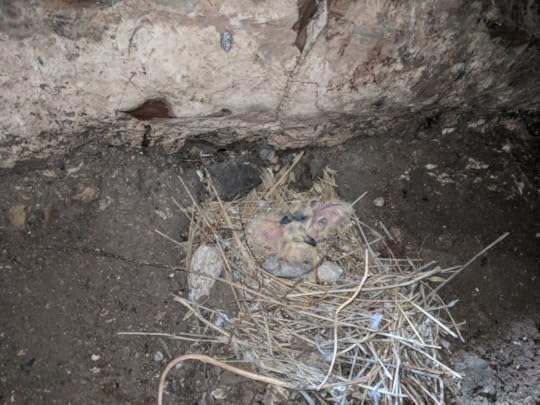 Young pigeons waiting for foodThe singing of the doves was accompanied by music from the bats who roosted overhead. We cleaned out high quality fertilizer, which was a byproduct of both the doves and the bats.
Young pigeons waiting for foodThe singing of the doves was accompanied by music from the bats who roosted overhead. We cleaned out high quality fertilizer, which was a byproduct of both the doves and the bats.
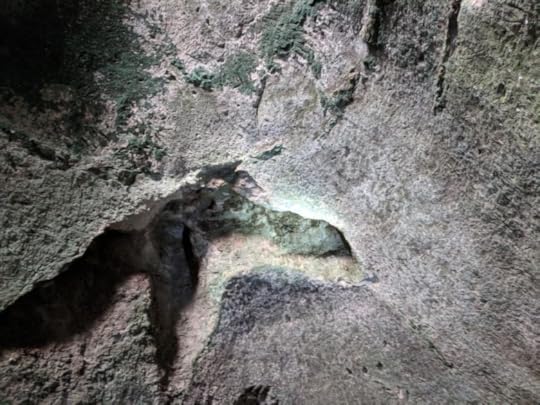 Bats hanging in a ceiling creaviceWe also met millipedes, slugs, various kinds of beetles and rolly-pollies.
Bats hanging in a ceiling creaviceWe also met millipedes, slugs, various kinds of beetles and rolly-pollies.
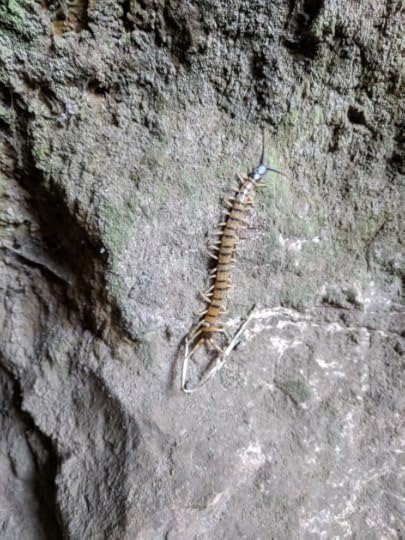 The visitor with a hundred feetThere is a Canaanite period house which was built between the city walls and the water project, which retains (after 4,000) walls which remain standing almost the original height
The visitor with a hundred feetThere is a Canaanite period house which was built between the city walls and the water project, which retains (after 4,000) walls which remain standing almost the original height
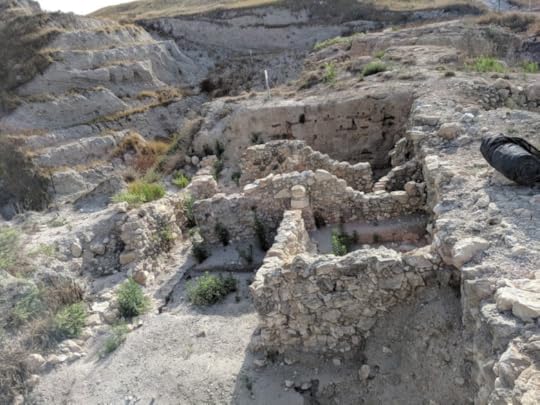 The Canaanite HouseThe city also contains a Solomonic era gate,
The Canaanite HouseThe city also contains a Solomonic era gate,
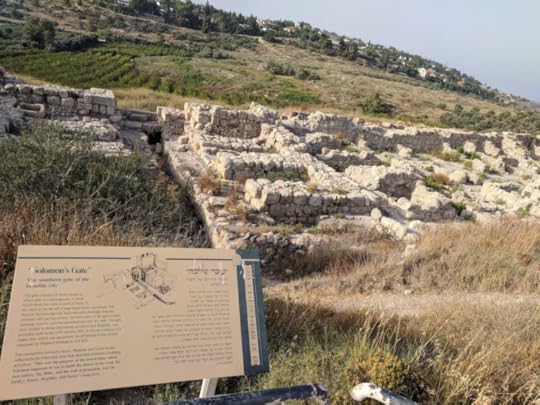 The city gate with water drainage in the middleAnd an 8th century BC house.
The city gate with water drainage in the middleAnd an 8th century BC house.
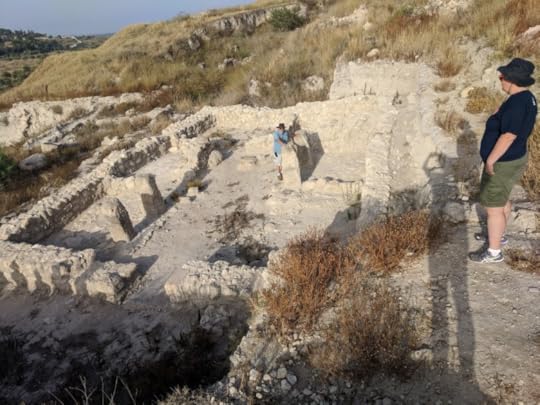 Typical four room Semetic House of the 8th Century
Typical four room Semetic House of the 8th Century
We have a team of about 25 people working in two areas at Gezer and one area at Tel Hadid.
 Canaanite area at Tel Gezer. Canaanite house under tarp, Gate to left, the tower is to the right of the bridge.We are working in an area which that was developed during the Canaanite period.
Canaanite area at Tel Gezer. Canaanite house under tarp, Gate to left, the tower is to the right of the bridge.We are working in an area which that was developed during the Canaanite period.  The water project is the large hole in frontDr. Warner, who has been working at Gezer for more than a dozen summers walked us around the site pointing out different areas. He pointed out various features of the site. One area was the Canaanite Gate with its massive entrance and mud bricks.
The water project is the large hole in frontDr. Warner, who has been working at Gezer for more than a dozen summers walked us around the site pointing out different areas. He pointed out various features of the site. One area was the Canaanite Gate with its massive entrance and mud bricks. The Canaanite Gate at GezerAnother area he highlighted was a massive tower for the protection of the city. The base of the tower is at least 45’ by 55’ in area. The tower probably stood 40’ tall with an additional mud brick structure above that.
The Canaanite Gate at GezerAnother area he highlighted was a massive tower for the protection of the city. The base of the tower is at least 45’ by 55’ in area. The tower probably stood 40’ tall with an additional mud brick structure above that. The remains of the huge tower at GezerDuring a 150 year period of peace, the Canaanite cities launched aggressive building programs. City walls became massive, with large gates and watchtowers. Other projects were also undertaken.
The remains of the huge tower at GezerDuring a 150 year period of peace, the Canaanite cities launched aggressive building programs. City walls became massive, with large gates and watchtowers. Other projects were also undertaken. Canaanite Tower from above
Canaanite Tower from aboveOne of these was the huge water project.
 The inside of the tunnel with hand carved arches aboveThe hand carved tunnel goes 180 feet under the ground, and then laterally.
The inside of the tunnel with hand carved arches aboveThe hand carved tunnel goes 180 feet under the ground, and then laterally.  The team cleaning the steps of the TunnelMy project the first two days is to clean steps. After 4,000 years without maid service, needless to say, they are a bit dirty. The pigeons and bats who live in the cave also leave reminders of their presence.
The team cleaning the steps of the TunnelMy project the first two days is to clean steps. After 4,000 years without maid service, needless to say, they are a bit dirty. The pigeons and bats who live in the cave also leave reminders of their presence. Safety features included the ladder and the hand ropeAs we cleaned the steps, we learned that various critters live in the cave. We heard the singing of pigeons, who fluttered in and out of the cave. We met some of their offspring.
Safety features included the ladder and the hand ropeAs we cleaned the steps, we learned that various critters live in the cave. We heard the singing of pigeons, who fluttered in and out of the cave. We met some of their offspring. Young pigeons waiting for foodThe singing of the doves was accompanied by music from the bats who roosted overhead. We cleaned out high quality fertilizer, which was a byproduct of both the doves and the bats.
Young pigeons waiting for foodThe singing of the doves was accompanied by music from the bats who roosted overhead. We cleaned out high quality fertilizer, which was a byproduct of both the doves and the bats. Bats hanging in a ceiling creaviceWe also met millipedes, slugs, various kinds of beetles and rolly-pollies.
Bats hanging in a ceiling creaviceWe also met millipedes, slugs, various kinds of beetles and rolly-pollies. The visitor with a hundred feetThere is a Canaanite period house which was built between the city walls and the water project, which retains (after 4,000) walls which remain standing almost the original height
The visitor with a hundred feetThere is a Canaanite period house which was built between the city walls and the water project, which retains (after 4,000) walls which remain standing almost the original height The Canaanite HouseThe city also contains a Solomonic era gate,
The Canaanite HouseThe city also contains a Solomonic era gate, The city gate with water drainage in the middleAnd an 8th century BC house.
The city gate with water drainage in the middleAnd an 8th century BC house. Typical four room Semetic House of the 8th Century
Typical four room Semetic House of the 8th CenturyWe have a team of about 25 people working in two areas at Gezer and one area at Tel Hadid.
Published on May 28, 2018 07:41
May 27, 2018
A Hike to the Monastery
Yesterday was Shabbat in Israel, and at Neve Shalom it was a time for settling in. Most of the team arrived yesterday, and is still recovering from jet lag. After a good night’s sleep, most of the team went to the crowded city of Jerusalem. Because I was there last week, I stayed at the hotel and took a hike to Latrun Monastery.
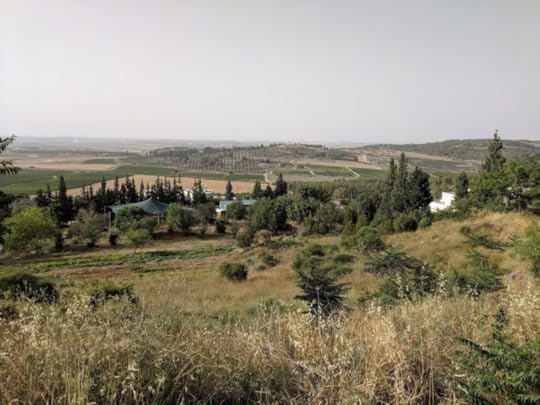 A view of the Monastery from Neve ShalomThe hike began with a downhill walk from Neve Shalom into the Ayalon Valley. The Trappist Monks earn an income by raising grapes and olives.
A view of the Monastery from Neve ShalomThe hike began with a downhill walk from Neve Shalom into the Ayalon Valley. The Trappist Monks earn an income by raising grapes and olives.
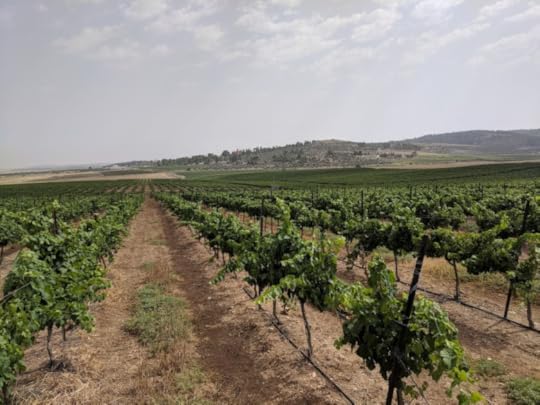 There are many grape vineyards around Latrun MonasteryI crossed through the vineyards on the way to the church.
There are many grape vineyards around Latrun MonasteryI crossed through the vineyards on the way to the church.
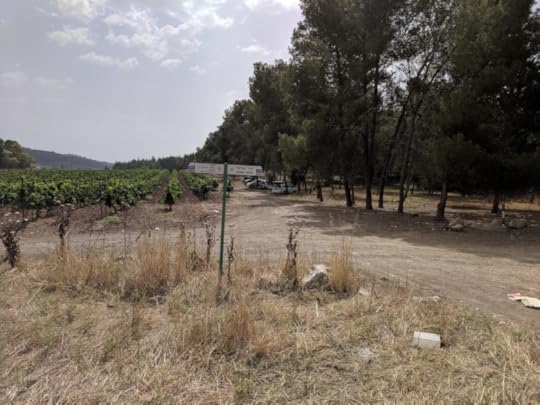 The Burma Road was the back road that saved JerusalemAs I was crossing the valley, I walked along the Burma Road. This road was cut from Latrun to Jerusalem in 1949, in order to provide supplies to the Jewish population of the “International city of Jerusalem” when Jordan cut off all access, in order to drive the Israelis out of the city. The road was being used by dirt bikes during my morning hike.
The Burma Road was the back road that saved JerusalemAs I was crossing the valley, I walked along the Burma Road. This road was cut from Latrun to Jerusalem in 1949, in order to provide supplies to the Jewish population of the “International city of Jerusalem” when Jordan cut off all access, in order to drive the Israelis out of the city. The road was being used by dirt bikes during my morning hike.
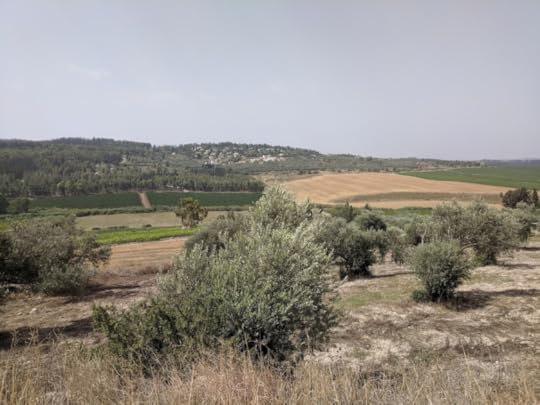 Olive Orchards maintained by the Trappist MonksI climbed out of the valley to ruins which sit on top of the hill. I was told this was an old fortress built by the Ottoman Turks. It is listed on Google Maps as a Crusader Fortress.
Olive Orchards maintained by the Trappist MonksI climbed out of the valley to ruins which sit on top of the hill. I was told this was an old fortress built by the Ottoman Turks. It is listed on Google Maps as a Crusader Fortress.
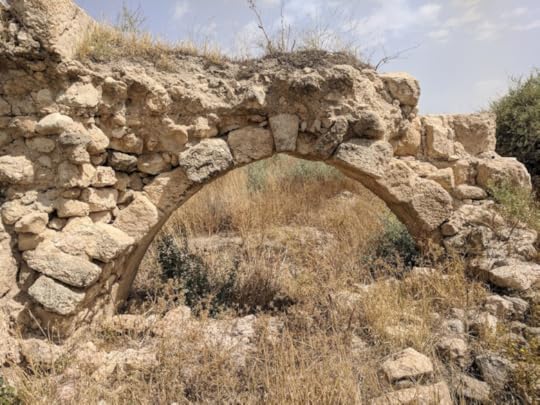 Window (or door) in the ruins on top of Latrun HillThe place is probably both, as the protective hill at Latrun has been a battle site throughout the history of the area. This is where the sun stood still for Joshua.
Window (or door) in the ruins on top of Latrun HillThe place is probably both, as the protective hill at Latrun has been a battle site throughout the history of the area. This is where the sun stood still for Joshua.
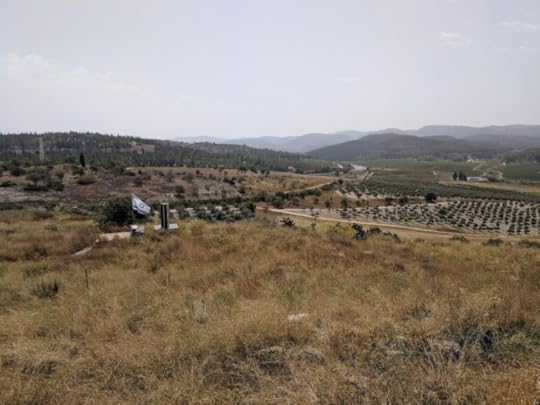 Looking toward Jerusalem from Latrun Hill. Highway 1 is belowThere are records of battles fought by King Saul and the Maccabees in this area. There were battles in 1949, 1967 and at other times.
Looking toward Jerusalem from Latrun Hill. Highway 1 is belowThere are records of battles fought by King Saul and the Maccabees in this area. There were battles in 1949, 1967 and at other times.
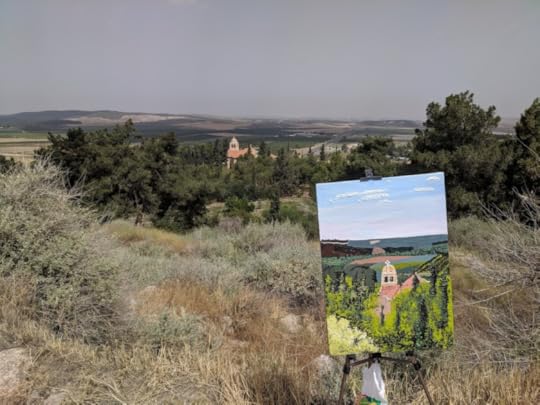 Painting in process of the MonasteryI met an artist on top of the hill who was painting the Latrun Church.
Painting in process of the MonasteryI met an artist on top of the hill who was painting the Latrun Church.
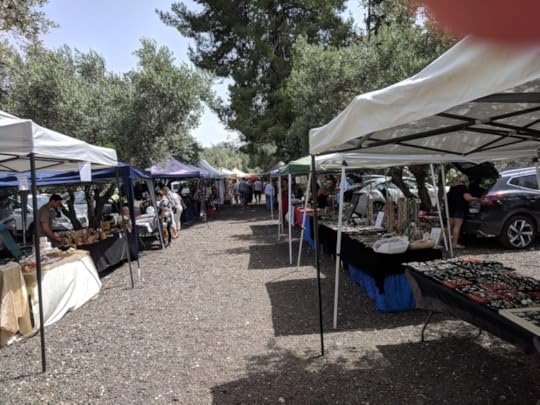 Arts & Crafts at Latrun MonasteryI walked down to the church, and found an arts and crafts festival which was crowded with people. This was because it was Shabbat.
Arts & Crafts at Latrun MonasteryI walked down to the church, and found an arts and crafts festival which was crowded with people. This was because it was Shabbat.
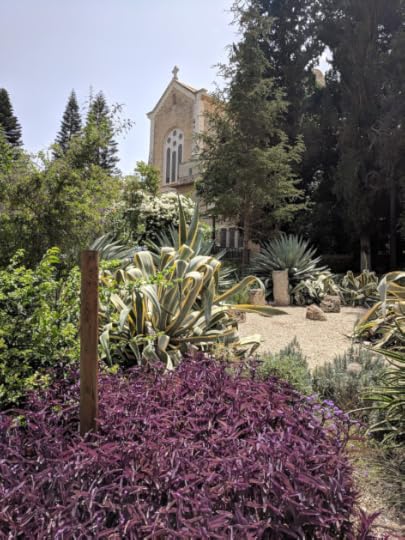 The Church gardens at LatrunI then went into the church, which is surrounded by gardens.
The Church gardens at LatrunI then went into the church, which is surrounded by gardens.
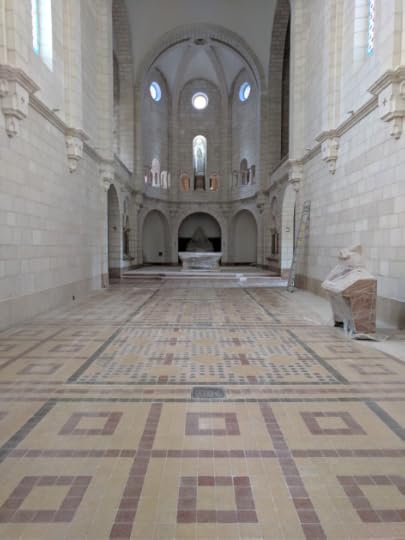 The church in process of restoration at LatrunThe church is in the process of restoration. There are no pews, but the building is very beautiful.
The church in process of restoration at LatrunThe church is in the process of restoration. There are no pews, but the building is very beautiful.
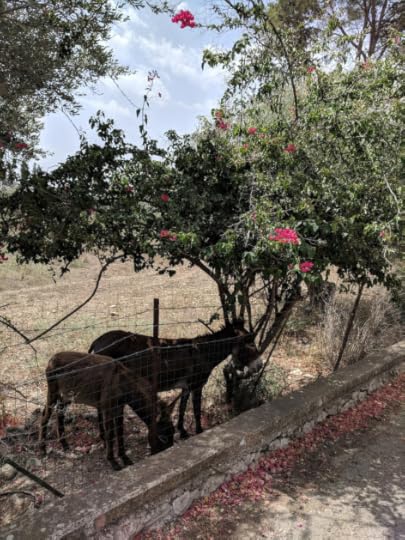 Two donkeys in the church yardI met some donkeys along the way.
Two donkeys in the church yardI met some donkeys along the way.
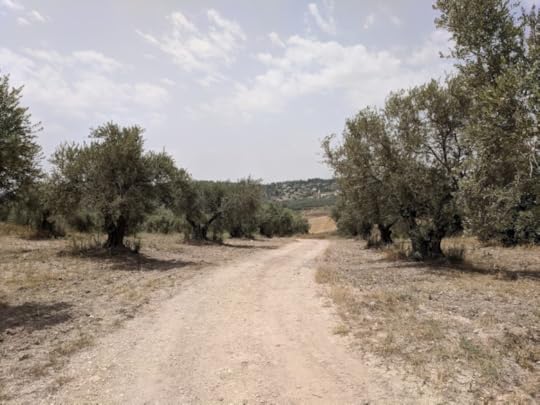 The road home with Neve Shalom in the background
The road home with Neve Shalom in the background
Then I returned across the valley and up the hill to Neve Shalom.
 A view of the Monastery from Neve ShalomThe hike began with a downhill walk from Neve Shalom into the Ayalon Valley. The Trappist Monks earn an income by raising grapes and olives.
A view of the Monastery from Neve ShalomThe hike began with a downhill walk from Neve Shalom into the Ayalon Valley. The Trappist Monks earn an income by raising grapes and olives. There are many grape vineyards around Latrun MonasteryI crossed through the vineyards on the way to the church.
There are many grape vineyards around Latrun MonasteryI crossed through the vineyards on the way to the church. The Burma Road was the back road that saved JerusalemAs I was crossing the valley, I walked along the Burma Road. This road was cut from Latrun to Jerusalem in 1949, in order to provide supplies to the Jewish population of the “International city of Jerusalem” when Jordan cut off all access, in order to drive the Israelis out of the city. The road was being used by dirt bikes during my morning hike.
The Burma Road was the back road that saved JerusalemAs I was crossing the valley, I walked along the Burma Road. This road was cut from Latrun to Jerusalem in 1949, in order to provide supplies to the Jewish population of the “International city of Jerusalem” when Jordan cut off all access, in order to drive the Israelis out of the city. The road was being used by dirt bikes during my morning hike. Olive Orchards maintained by the Trappist MonksI climbed out of the valley to ruins which sit on top of the hill. I was told this was an old fortress built by the Ottoman Turks. It is listed on Google Maps as a Crusader Fortress.
Olive Orchards maintained by the Trappist MonksI climbed out of the valley to ruins which sit on top of the hill. I was told this was an old fortress built by the Ottoman Turks. It is listed on Google Maps as a Crusader Fortress. Window (or door) in the ruins on top of Latrun HillThe place is probably both, as the protective hill at Latrun has been a battle site throughout the history of the area. This is where the sun stood still for Joshua.
Window (or door) in the ruins on top of Latrun HillThe place is probably both, as the protective hill at Latrun has been a battle site throughout the history of the area. This is where the sun stood still for Joshua. Looking toward Jerusalem from Latrun Hill. Highway 1 is belowThere are records of battles fought by King Saul and the Maccabees in this area. There were battles in 1949, 1967 and at other times.
Looking toward Jerusalem from Latrun Hill. Highway 1 is belowThere are records of battles fought by King Saul and the Maccabees in this area. There were battles in 1949, 1967 and at other times. Painting in process of the MonasteryI met an artist on top of the hill who was painting the Latrun Church.
Painting in process of the MonasteryI met an artist on top of the hill who was painting the Latrun Church. Arts & Crafts at Latrun MonasteryI walked down to the church, and found an arts and crafts festival which was crowded with people. This was because it was Shabbat.
Arts & Crafts at Latrun MonasteryI walked down to the church, and found an arts and crafts festival which was crowded with people. This was because it was Shabbat. The Church gardens at LatrunI then went into the church, which is surrounded by gardens.
The Church gardens at LatrunI then went into the church, which is surrounded by gardens. The church in process of restoration at LatrunThe church is in the process of restoration. There are no pews, but the building is very beautiful.
The church in process of restoration at LatrunThe church is in the process of restoration. There are no pews, but the building is very beautiful. Two donkeys in the church yardI met some donkeys along the way.
Two donkeys in the church yardI met some donkeys along the way. The road home with Neve Shalom in the background
The road home with Neve Shalom in the backgroundThen I returned across the valley and up the hill to Neve Shalom.
Published on May 27, 2018 03:30
May 26, 2018
Lodging at Neve Shalom
Today we made the transition from Haifa to the Ayalon Valley, half way between Tel Aviv and Jerusalem. We are lodging at a Hotel called Neve Shalom, which means “New Peace.” 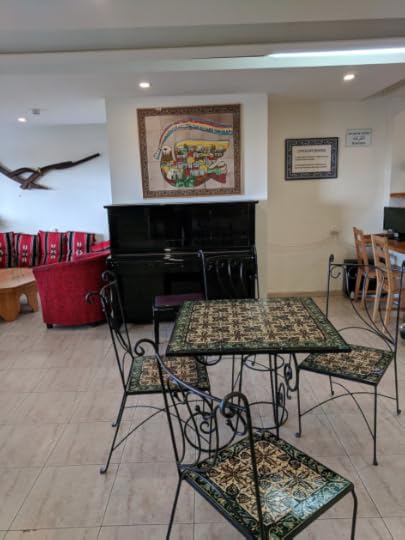 Lobby at Neve ShalomThe hotel sits in a community intentionally founded in 1970 in order to bring Jews and Arabs together in a place of peace. About 150 families live in the village, which has schools, a youth center and an art museum.
Lobby at Neve ShalomThe hotel sits in a community intentionally founded in 1970 in order to bring Jews and Arabs together in a place of peace. About 150 families live in the village, which has schools, a youth center and an art museum.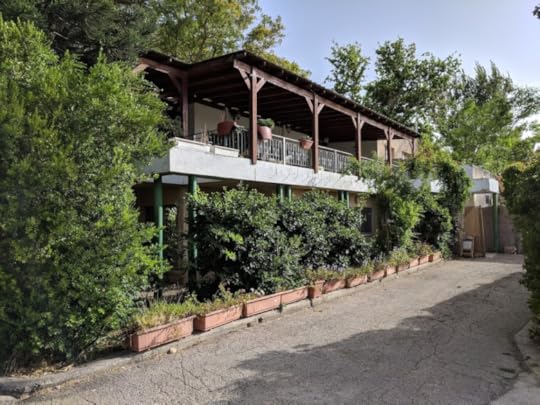 Lobby Patio at Neve ShalomThe rooms are small connected cottages which are arranged along the hillside. Each room has a private entrance and a patio. Steps lead from one set of apartments to the next.
Lobby Patio at Neve ShalomThe rooms are small connected cottages which are arranged along the hillside. Each room has a private entrance and a patio. Steps lead from one set of apartments to the next.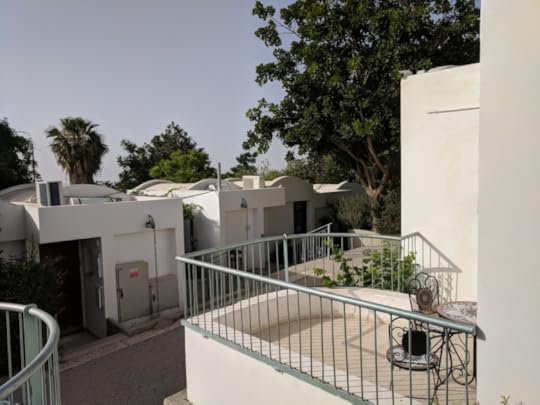 Cottage style rooms at Neve ShalomMiddle Eastern cuisine in the dining room for both breakfast and supper. There is a small cafe and a gift shop located in the village. We ate lunch there and the food was quite tasty.
Cottage style rooms at Neve ShalomMiddle Eastern cuisine in the dining room for both breakfast and supper. There is a small cafe and a gift shop located in the village. We ate lunch there and the food was quite tasty.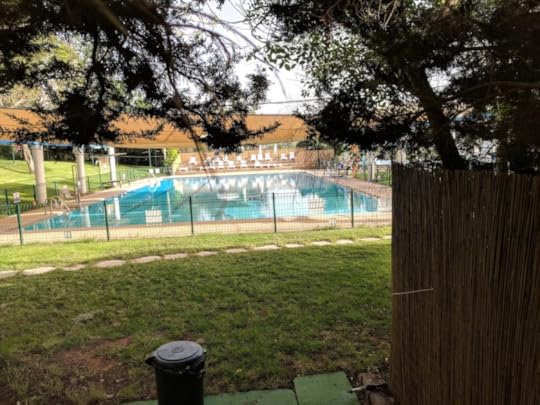 Swimming Pool at Neve ShalomThe community of Neve Shalom has a swimming pool, which we will visit each day after our work in this area, an archeological dig at Tel Gezer.
Swimming Pool at Neve ShalomThe community of Neve Shalom has a swimming pool, which we will visit each day after our work in this area, an archeological dig at Tel Gezer.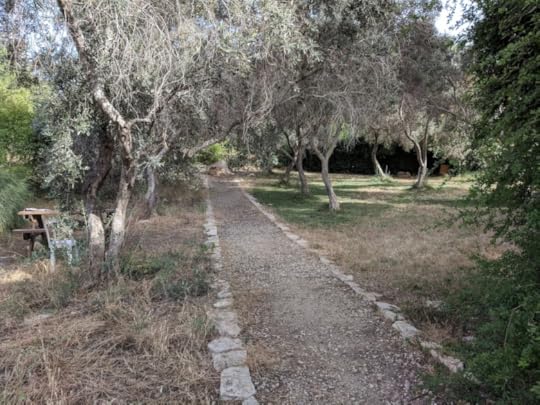 Olive Grove at Neve ShalomThere are seating areas located around the facility which are designed to allow for meditation.
Olive Grove at Neve ShalomThere are seating areas located around the facility which are designed to allow for meditation.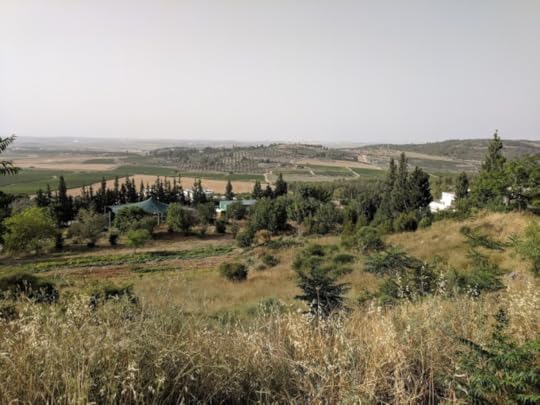 The View from Neve Shalom to the the Trappist Monastery and Modi'inThe hotel is on a hill which overlooks the Ayalon Valley. Across the valley is a Trappist Monastery, and beyond the church the highrises of Modi’in are visible in the background.
The View from Neve Shalom to the the Trappist Monastery and Modi'inThe hotel is on a hill which overlooks the Ayalon Valley. Across the valley is a Trappist Monastery, and beyond the church the highrises of Modi’in are visible in the background.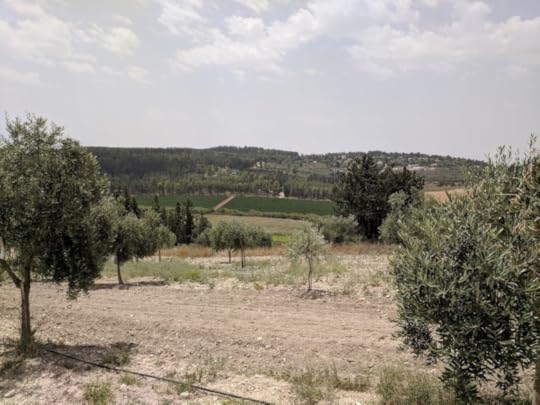 Looking across the valley to Neve ShalomThe team which digs a Tel Gezer, along with many other teams stay at Neve Shalom. Several tem members have spent three weeks at this hotel every summer for more than ten years.
Looking across the valley to Neve ShalomThe team which digs a Tel Gezer, along with many other teams stay at Neve Shalom. Several tem members have spent three weeks at this hotel every summer for more than ten years.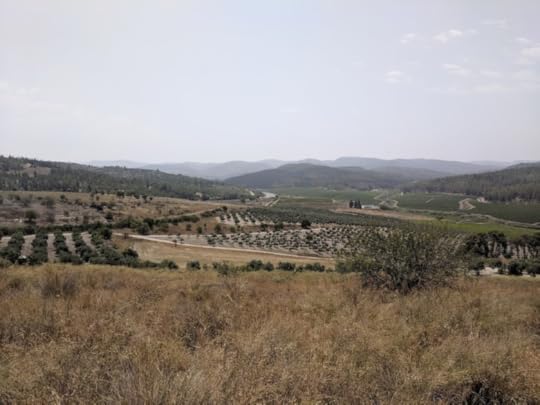 Looking up to JerusalemNeve Shalom is located in a place in Israel with a history of border disputes. The Ayalon valley narrows as it leads up into the hills. This is the place where the sun stood still for Joshua. In 1949, the land on which the hotel sits was “no man’s land,” part of the demilitarized zone between Israel and Jordan.
Looking up to JerusalemNeve Shalom is located in a place in Israel with a history of border disputes. The Ayalon valley narrows as it leads up into the hills. This is the place where the sun stood still for Joshua. In 1949, the land on which the hotel sits was “no man’s land,” part of the demilitarized zone between Israel and Jordan.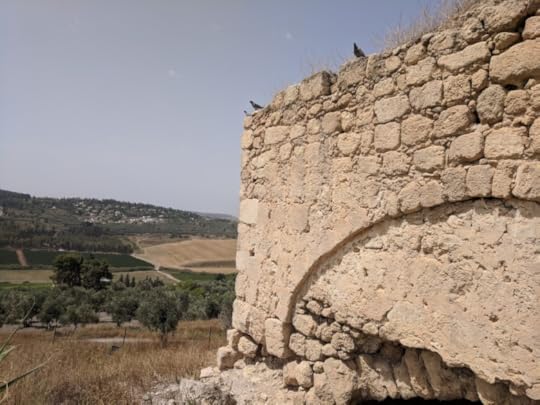 A Fortress with Neve Shalom in the background
A Fortress with Neve Shalom in the background
The most difficult battles of the six day war in 1967, were fought around this location. Once the battle was over and the land was secured for Israel, the hotel was built.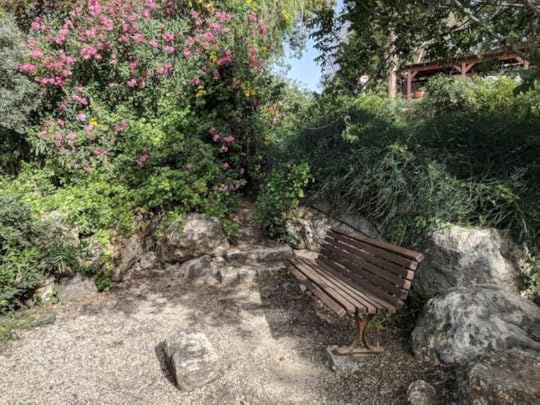 A Bench for Prayer at Neve Shalom
A Bench for Prayer at Neve Shalom
There were both Arab and Jewish communities in the area. It was the dream of Father Bruno Hussar to see Arabs and Jews living in peace. His goal is accomplished through the community called Neve Shalom.
 Lobby at Neve ShalomThe hotel sits in a community intentionally founded in 1970 in order to bring Jews and Arabs together in a place of peace. About 150 families live in the village, which has schools, a youth center and an art museum.
Lobby at Neve ShalomThe hotel sits in a community intentionally founded in 1970 in order to bring Jews and Arabs together in a place of peace. About 150 families live in the village, which has schools, a youth center and an art museum. Lobby Patio at Neve ShalomThe rooms are small connected cottages which are arranged along the hillside. Each room has a private entrance and a patio. Steps lead from one set of apartments to the next.
Lobby Patio at Neve ShalomThe rooms are small connected cottages which are arranged along the hillside. Each room has a private entrance and a patio. Steps lead from one set of apartments to the next. Cottage style rooms at Neve ShalomMiddle Eastern cuisine in the dining room for both breakfast and supper. There is a small cafe and a gift shop located in the village. We ate lunch there and the food was quite tasty.
Cottage style rooms at Neve ShalomMiddle Eastern cuisine in the dining room for both breakfast and supper. There is a small cafe and a gift shop located in the village. We ate lunch there and the food was quite tasty. Swimming Pool at Neve ShalomThe community of Neve Shalom has a swimming pool, which we will visit each day after our work in this area, an archeological dig at Tel Gezer.
Swimming Pool at Neve ShalomThe community of Neve Shalom has a swimming pool, which we will visit each day after our work in this area, an archeological dig at Tel Gezer. Olive Grove at Neve ShalomThere are seating areas located around the facility which are designed to allow for meditation.
Olive Grove at Neve ShalomThere are seating areas located around the facility which are designed to allow for meditation. The View from Neve Shalom to the the Trappist Monastery and Modi'inThe hotel is on a hill which overlooks the Ayalon Valley. Across the valley is a Trappist Monastery, and beyond the church the highrises of Modi’in are visible in the background.
The View from Neve Shalom to the the Trappist Monastery and Modi'inThe hotel is on a hill which overlooks the Ayalon Valley. Across the valley is a Trappist Monastery, and beyond the church the highrises of Modi’in are visible in the background. Looking across the valley to Neve ShalomThe team which digs a Tel Gezer, along with many other teams stay at Neve Shalom. Several tem members have spent three weeks at this hotel every summer for more than ten years.
Looking across the valley to Neve ShalomThe team which digs a Tel Gezer, along with many other teams stay at Neve Shalom. Several tem members have spent three weeks at this hotel every summer for more than ten years. Looking up to JerusalemNeve Shalom is located in a place in Israel with a history of border disputes. The Ayalon valley narrows as it leads up into the hills. This is the place where the sun stood still for Joshua. In 1949, the land on which the hotel sits was “no man’s land,” part of the demilitarized zone between Israel and Jordan.
Looking up to JerusalemNeve Shalom is located in a place in Israel with a history of border disputes. The Ayalon valley narrows as it leads up into the hills. This is the place where the sun stood still for Joshua. In 1949, the land on which the hotel sits was “no man’s land,” part of the demilitarized zone between Israel and Jordan. A Fortress with Neve Shalom in the background
A Fortress with Neve Shalom in the backgroundThe most difficult battles of the six day war in 1967, were fought around this location. Once the battle was over and the land was secured for Israel, the hotel was built.
 A Bench for Prayer at Neve Shalom
A Bench for Prayer at Neve ShalomThere were both Arab and Jewish communities in the area. It was the dream of Father Bruno Hussar to see Arabs and Jews living in peace. His goal is accomplished through the community called Neve Shalom.
Published on May 26, 2018 08:08
May 24, 2018
A Day at the Beach
One of our favorite places to visit in Israel is the seashore. The Mediterranean laps the western side of Israel along the western boundary of the country, from the Negev to the border with Lebanon. 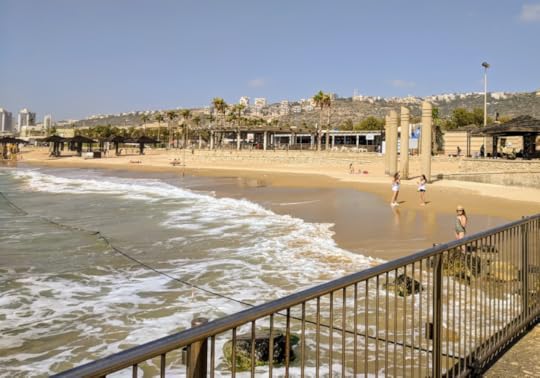 The Boardwalk in Haifa, IsraelThe seacoast is enjoyed by many people because the climate of Israel is warm most of the year to encourage people to come out and enjoy the beach.
The Boardwalk in Haifa, IsraelThe seacoast is enjoyed by many people because the climate of Israel is warm most of the year to encourage people to come out and enjoy the beach.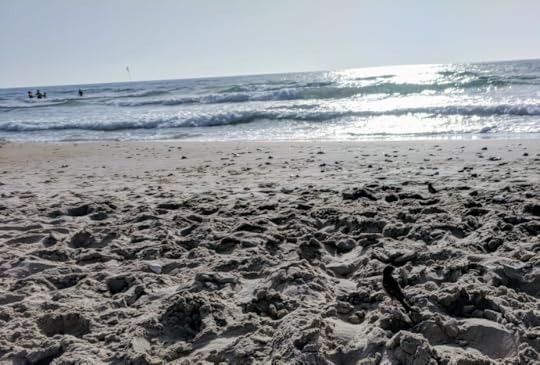 A Sparrow on the BeachThe beaches in Israel are of a light sand the length of the Mediterranean coast. Many shells can be found on the beaches, especially in the south. The northern beaches contain more smooth rocks. In the area around Caesarea it can be seen how some of the sand is brought from the trade winds over the Sahara Desert to build the beaches.
A Sparrow on the BeachThe beaches in Israel are of a light sand the length of the Mediterranean coast. Many shells can be found on the beaches, especially in the south. The northern beaches contain more smooth rocks. In the area around Caesarea it can be seen how some of the sand is brought from the trade winds over the Sahara Desert to build the beaches. 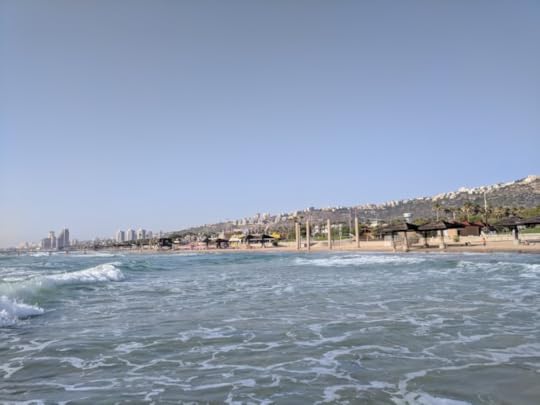 Mount Carmel rises above Dado BeachThe beach around Haifa rests beneath the heights of Mount Carmel. In all probability the Prophet Elijah not only came west on Mount Carmel to look for clouds, but he also dipped his feet into the Mediterranean. There is a cave in Haifa near the shore that is called Elijah’s Cave.
Mount Carmel rises above Dado BeachThe beach around Haifa rests beneath the heights of Mount Carmel. In all probability the Prophet Elijah not only came west on Mount Carmel to look for clouds, but he also dipped his feet into the Mediterranean. There is a cave in Haifa near the shore that is called Elijah’s Cave.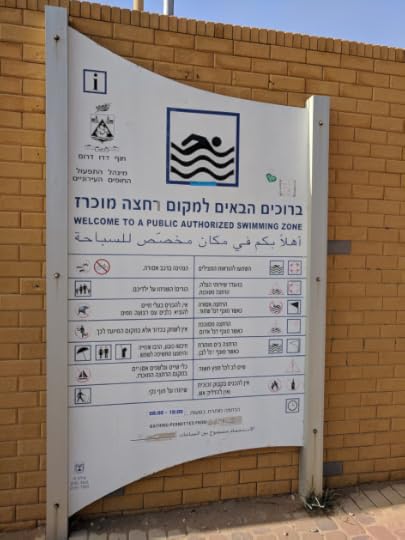 Information Sign at the Haifa BeachIsrael has several protective sea ports. The first and oldest of the parts is at Yafo (Joppa) where Jonah took a ship and went west to escape God. The port was created by a small indention in the coast, and a roc barrier to the south. The view across this inlet from Yafo to Tel Aviv is quite beautiful.
Information Sign at the Haifa BeachIsrael has several protective sea ports. The first and oldest of the parts is at Yafo (Joppa) where Jonah took a ship and went west to escape God. The port was created by a small indention in the coast, and a roc barrier to the south. The view across this inlet from Yafo to Tel Aviv is quite beautiful.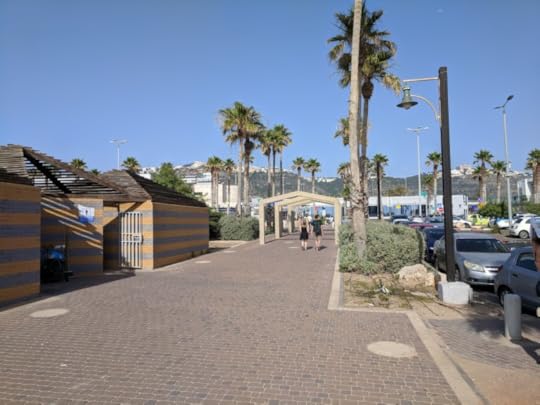 Entrance to the Carmel Beach in HaifaA sign at the top of Mt. Carmel says that the only place in Israel you can look north across the Mediterranean Sea is in Haifa. The seacoast in this part of Haifa is a huge seaport. From the top of the mountain cargo ships from around the world can be seen attempting to get in and to deliver their cargo.
Entrance to the Carmel Beach in HaifaA sign at the top of Mt. Carmel says that the only place in Israel you can look north across the Mediterranean Sea is in Haifa. The seacoast in this part of Haifa is a huge seaport. From the top of the mountain cargo ships from around the world can be seen attempting to get in and to deliver their cargo.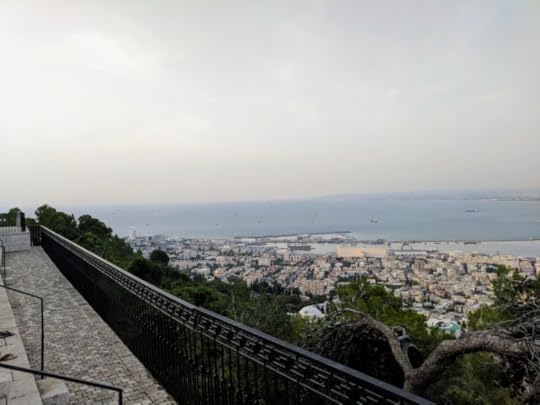 Looking North from the top of Mount CarmelThe northern seacoast of Israel can be easily observed from the top of Mount Carmel from Haifa to Akhziv National Park, which borders Lebanon. This is a beautiful area which contains some rock crevices and underwater caves produced by the waves striking the limestone cliffs. The area is called Rosh Hanikra.
Looking North from the top of Mount CarmelThe northern seacoast of Israel can be easily observed from the top of Mount Carmel from Haifa to Akhziv National Park, which borders Lebanon. This is a beautiful area which contains some rock crevices and underwater caves produced by the waves striking the limestone cliffs. The area is called Rosh Hanikra.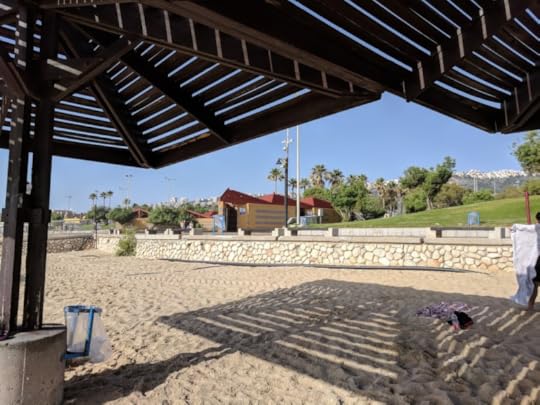 Shelters along the beach in HaifaThe main beaches in Israel like many other peaches around the world. There are wide boardwalks which divide the beaches from the shops. Along the beaches there are shelters, monuments, and plenty of space to spread a towel. There are many restaurants and other shops along the boardwalk, and also bathrooms where people can get changed.
Shelters along the beach in HaifaThe main beaches in Israel like many other peaches around the world. There are wide boardwalks which divide the beaches from the shops. Along the beaches there are shelters, monuments, and plenty of space to spread a towel. There are many restaurants and other shops along the boardwalk, and also bathrooms where people can get changed.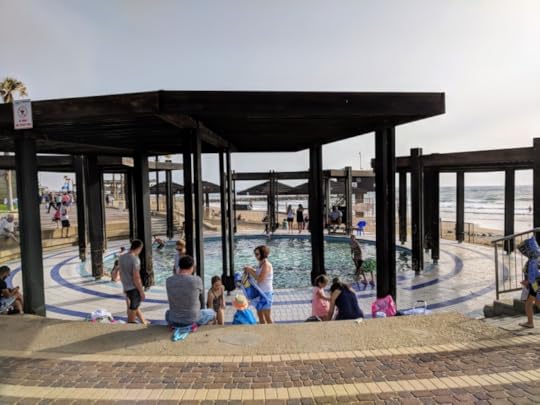 A Fresh water Swimming placeIsrael’s beaches are filled with people of all ages from children to senior adults all playing in the waves strolling the beaches picking up seashells, surfing, and swimming.
A Fresh water Swimming placeIsrael’s beaches are filled with people of all ages from children to senior adults all playing in the waves strolling the beaches picking up seashells, surfing, and swimming.
 The Boardwalk in Haifa, IsraelThe seacoast is enjoyed by many people because the climate of Israel is warm most of the year to encourage people to come out and enjoy the beach.
The Boardwalk in Haifa, IsraelThe seacoast is enjoyed by many people because the climate of Israel is warm most of the year to encourage people to come out and enjoy the beach. A Sparrow on the BeachThe beaches in Israel are of a light sand the length of the Mediterranean coast. Many shells can be found on the beaches, especially in the south. The northern beaches contain more smooth rocks. In the area around Caesarea it can be seen how some of the sand is brought from the trade winds over the Sahara Desert to build the beaches.
A Sparrow on the BeachThe beaches in Israel are of a light sand the length of the Mediterranean coast. Many shells can be found on the beaches, especially in the south. The northern beaches contain more smooth rocks. In the area around Caesarea it can be seen how some of the sand is brought from the trade winds over the Sahara Desert to build the beaches.  Mount Carmel rises above Dado BeachThe beach around Haifa rests beneath the heights of Mount Carmel. In all probability the Prophet Elijah not only came west on Mount Carmel to look for clouds, but he also dipped his feet into the Mediterranean. There is a cave in Haifa near the shore that is called Elijah’s Cave.
Mount Carmel rises above Dado BeachThe beach around Haifa rests beneath the heights of Mount Carmel. In all probability the Prophet Elijah not only came west on Mount Carmel to look for clouds, but he also dipped his feet into the Mediterranean. There is a cave in Haifa near the shore that is called Elijah’s Cave. Information Sign at the Haifa BeachIsrael has several protective sea ports. The first and oldest of the parts is at Yafo (Joppa) where Jonah took a ship and went west to escape God. The port was created by a small indention in the coast, and a roc barrier to the south. The view across this inlet from Yafo to Tel Aviv is quite beautiful.
Information Sign at the Haifa BeachIsrael has several protective sea ports. The first and oldest of the parts is at Yafo (Joppa) where Jonah took a ship and went west to escape God. The port was created by a small indention in the coast, and a roc barrier to the south. The view across this inlet from Yafo to Tel Aviv is quite beautiful. Entrance to the Carmel Beach in HaifaA sign at the top of Mt. Carmel says that the only place in Israel you can look north across the Mediterranean Sea is in Haifa. The seacoast in this part of Haifa is a huge seaport. From the top of the mountain cargo ships from around the world can be seen attempting to get in and to deliver their cargo.
Entrance to the Carmel Beach in HaifaA sign at the top of Mt. Carmel says that the only place in Israel you can look north across the Mediterranean Sea is in Haifa. The seacoast in this part of Haifa is a huge seaport. From the top of the mountain cargo ships from around the world can be seen attempting to get in and to deliver their cargo. Looking North from the top of Mount CarmelThe northern seacoast of Israel can be easily observed from the top of Mount Carmel from Haifa to Akhziv National Park, which borders Lebanon. This is a beautiful area which contains some rock crevices and underwater caves produced by the waves striking the limestone cliffs. The area is called Rosh Hanikra.
Looking North from the top of Mount CarmelThe northern seacoast of Israel can be easily observed from the top of Mount Carmel from Haifa to Akhziv National Park, which borders Lebanon. This is a beautiful area which contains some rock crevices and underwater caves produced by the waves striking the limestone cliffs. The area is called Rosh Hanikra. Shelters along the beach in HaifaThe main beaches in Israel like many other peaches around the world. There are wide boardwalks which divide the beaches from the shops. Along the beaches there are shelters, monuments, and plenty of space to spread a towel. There are many restaurants and other shops along the boardwalk, and also bathrooms where people can get changed.
Shelters along the beach in HaifaThe main beaches in Israel like many other peaches around the world. There are wide boardwalks which divide the beaches from the shops. Along the beaches there are shelters, monuments, and plenty of space to spread a towel. There are many restaurants and other shops along the boardwalk, and also bathrooms where people can get changed. A Fresh water Swimming placeIsrael’s beaches are filled with people of all ages from children to senior adults all playing in the waves strolling the beaches picking up seashells, surfing, and swimming.
A Fresh water Swimming placeIsrael’s beaches are filled with people of all ages from children to senior adults all playing in the waves strolling the beaches picking up seashells, surfing, and swimming.
Published on May 24, 2018 22:29
May 23, 2018
Among the Tombs
Today we went to Bet She’arim and climbed around the tombs of the deceased. Bet She’arim is an archeological site located just north of the slopes of Mount Carmel and south of the mountains of Galilee.
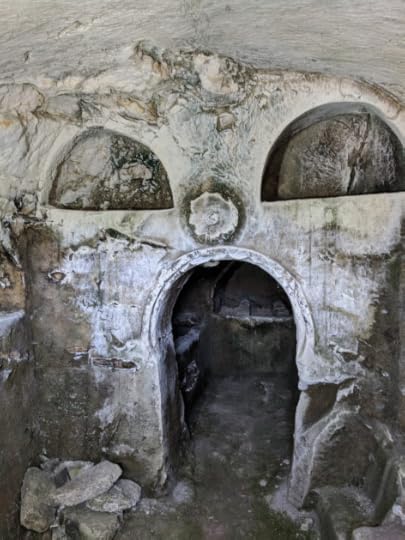 Tomb complex at Beit She'arimBernice, the daughter of King Agrippa I found the area so beautiful that she built an estate at Bet She’arim (called Besara in the life of Josephus) for her personal use. The land was filled with grain fields and also some orchards.
Tomb complex at Beit She'arimBernice, the daughter of King Agrippa I found the area so beautiful that she built an estate at Bet She’arim (called Besara in the life of Josephus) for her personal use. The land was filled with grain fields and also some orchards.
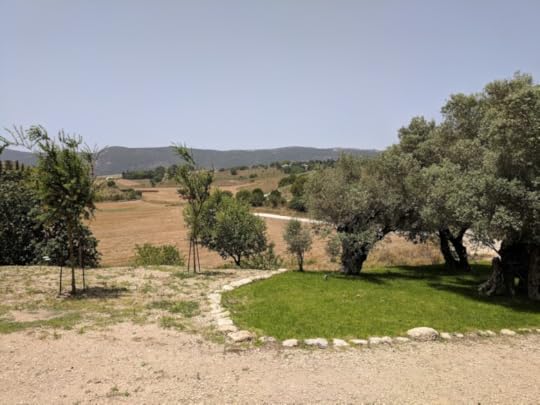 Pomegranates, Olives and fields of GrainThe wealth and beauty of the area drew the Sanhedrin move to this location for a period of time after the Temple in Jerusalem was destroyed (The court of 70 moved from Yavneh to Usha, Shefar’am, Bet She’arim, Sipporis, and finally to Tiberias).
Pomegranates, Olives and fields of GrainThe wealth and beauty of the area drew the Sanhedrin move to this location for a period of time after the Temple in Jerusalem was destroyed (The court of 70 moved from Yavneh to Usha, Shefar’am, Bet She’arim, Sipporis, and finally to Tiberias).
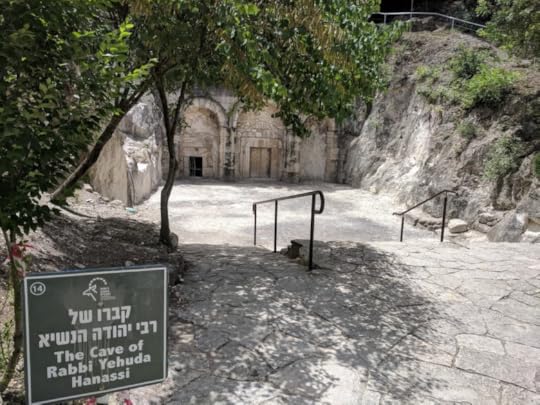 The tomb of Rabbi HanassiRabbi Yehuda Hanasi established a school in Bet She’arim. Although this great rabbi and the compiler of the mishnah moved to Tiberias after seventeen years,.he chose to be buried in a cave at Beit She'arim.
The tomb of Rabbi HanassiRabbi Yehuda Hanasi established a school in Bet She’arim. Although this great rabbi and the compiler of the mishnah moved to Tiberias after seventeen years,.he chose to be buried in a cave at Beit She'arim.
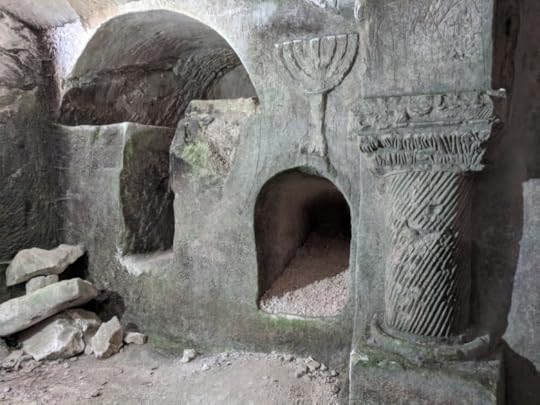 A Decorative Menorah in the TombsMany people from around the world greatly respected Rabbi Yehuda Hanasi for his teachings, and desired to be buried close to his tomb.
A Decorative Menorah in the TombsMany people from around the world greatly respected Rabbi Yehuda Hanasi for his teachings, and desired to be buried close to his tomb.
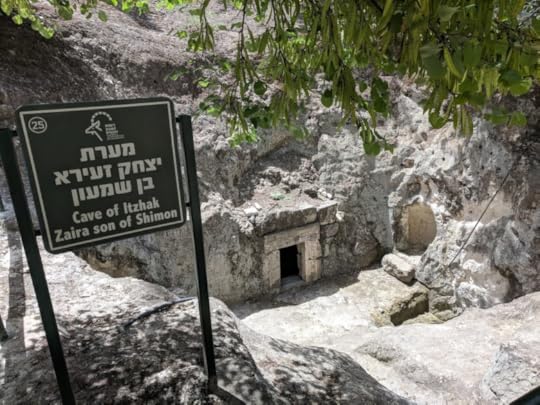 One of the Tomb ComplexesThe Talmud says, “Whoever is buried in the Land of Israel is deemed to be buried under the altar.” Some believed people buried elsewhere would need to roll underground all the way to Israel at the time of the great resurrection.
One of the Tomb ComplexesThe Talmud says, “Whoever is buried in the Land of Israel is deemed to be buried under the altar.” Some believed people buried elsewhere would need to roll underground all the way to Israel at the time of the great resurrection.
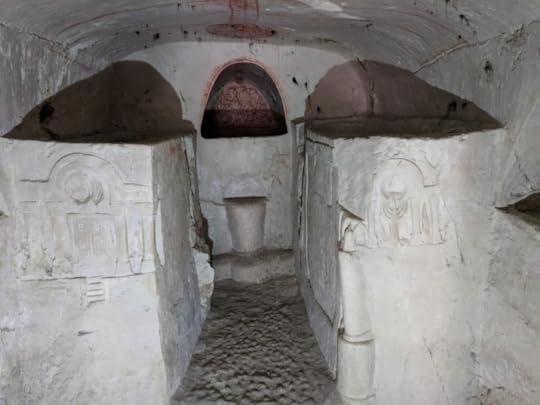 Cave of the Torah ArkThe tombs at Beit She'arim contain important people from Israel and beyond. People from Antioch, Palmyra, Byblos, Beirut, Sidon, Tyre, Yahmur, Phaena, Arabia, Caesarea, Himyar, and Etsion Gaber were buried at this site.
Cave of the Torah ArkThe tombs at Beit She'arim contain important people from Israel and beyond. People from Antioch, Palmyra, Byblos, Beirut, Sidon, Tyre, Yahmur, Phaena, Arabia, Caesarea, Himyar, and Etsion Gaber were buried at this site.
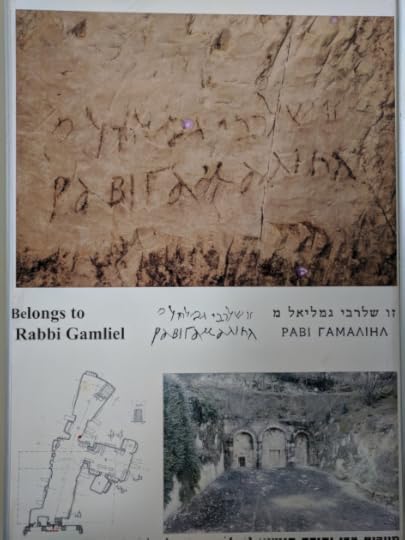 Grave of Rabbi GamlielLarge complexes of caves were built under the hills at Beit She'arim during the first three centuries of the Common Era. Some people were buried in wooden coffins, some in stone containers, some laid on limestone and placed into ossuaries. There are many inscriptions over niches in the caves written in Hebrew, Aramaic and Greek.
Grave of Rabbi GamlielLarge complexes of caves were built under the hills at Beit She'arim during the first three centuries of the Common Era. Some people were buried in wooden coffins, some in stone containers, some laid on limestone and placed into ossuaries. There are many inscriptions over niches in the caves written in Hebrew, Aramaic and Greek.
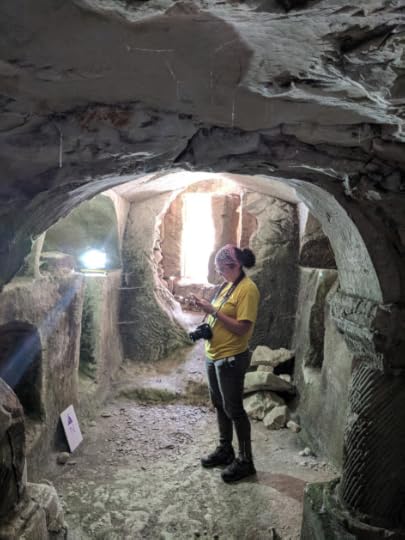 Photographer of the Tombs
Photographer of the Tombs
One inscription reads: “I, Justus, son of Leontius and Sappho, lie here dead / And after I had plucked the fruit of all wisdom / I left the light, the miserable parents, who mourn ceaselessly / and my brothers. Woe to me in Besara. / After descending to Hades, I Justus, lie here / with many of my people, for so willed stern fate. / Be comforted, Justus, no man is immortal.
 Tomb complex at Beit She'arimBernice, the daughter of King Agrippa I found the area so beautiful that she built an estate at Bet She’arim (called Besara in the life of Josephus) for her personal use. The land was filled with grain fields and also some orchards.
Tomb complex at Beit She'arimBernice, the daughter of King Agrippa I found the area so beautiful that she built an estate at Bet She’arim (called Besara in the life of Josephus) for her personal use. The land was filled with grain fields and also some orchards. Pomegranates, Olives and fields of GrainThe wealth and beauty of the area drew the Sanhedrin move to this location for a period of time after the Temple in Jerusalem was destroyed (The court of 70 moved from Yavneh to Usha, Shefar’am, Bet She’arim, Sipporis, and finally to Tiberias).
Pomegranates, Olives and fields of GrainThe wealth and beauty of the area drew the Sanhedrin move to this location for a period of time after the Temple in Jerusalem was destroyed (The court of 70 moved from Yavneh to Usha, Shefar’am, Bet She’arim, Sipporis, and finally to Tiberias).  The tomb of Rabbi HanassiRabbi Yehuda Hanasi established a school in Bet She’arim. Although this great rabbi and the compiler of the mishnah moved to Tiberias after seventeen years,.he chose to be buried in a cave at Beit She'arim.
The tomb of Rabbi HanassiRabbi Yehuda Hanasi established a school in Bet She’arim. Although this great rabbi and the compiler of the mishnah moved to Tiberias after seventeen years,.he chose to be buried in a cave at Beit She'arim. A Decorative Menorah in the TombsMany people from around the world greatly respected Rabbi Yehuda Hanasi for his teachings, and desired to be buried close to his tomb.
A Decorative Menorah in the TombsMany people from around the world greatly respected Rabbi Yehuda Hanasi for his teachings, and desired to be buried close to his tomb. One of the Tomb ComplexesThe Talmud says, “Whoever is buried in the Land of Israel is deemed to be buried under the altar.” Some believed people buried elsewhere would need to roll underground all the way to Israel at the time of the great resurrection.
One of the Tomb ComplexesThe Talmud says, “Whoever is buried in the Land of Israel is deemed to be buried under the altar.” Some believed people buried elsewhere would need to roll underground all the way to Israel at the time of the great resurrection. Cave of the Torah ArkThe tombs at Beit She'arim contain important people from Israel and beyond. People from Antioch, Palmyra, Byblos, Beirut, Sidon, Tyre, Yahmur, Phaena, Arabia, Caesarea, Himyar, and Etsion Gaber were buried at this site.
Cave of the Torah ArkThe tombs at Beit She'arim contain important people from Israel and beyond. People from Antioch, Palmyra, Byblos, Beirut, Sidon, Tyre, Yahmur, Phaena, Arabia, Caesarea, Himyar, and Etsion Gaber were buried at this site. Grave of Rabbi GamlielLarge complexes of caves were built under the hills at Beit She'arim during the first three centuries of the Common Era. Some people were buried in wooden coffins, some in stone containers, some laid on limestone and placed into ossuaries. There are many inscriptions over niches in the caves written in Hebrew, Aramaic and Greek.
Grave of Rabbi GamlielLarge complexes of caves were built under the hills at Beit She'arim during the first three centuries of the Common Era. Some people were buried in wooden coffins, some in stone containers, some laid on limestone and placed into ossuaries. There are many inscriptions over niches in the caves written in Hebrew, Aramaic and Greek. Photographer of the Tombs
Photographer of the TombsOne inscription reads: “I, Justus, son of Leontius and Sappho, lie here dead / And after I had plucked the fruit of all wisdom / I left the light, the miserable parents, who mourn ceaselessly / and my brothers. Woe to me in Besara. / After descending to Hades, I Justus, lie here / with many of my people, for so willed stern fate. / Be comforted, Justus, no man is immortal.
Published on May 23, 2018 21:48
May 22, 2018
A Trip to Tel Aviv
Yesterday we made a trip from Haifa to Tel Aviv. Transportation along the coast, the “Via Maris” or the “Plain of Sharon,” as it is variously called in different places, is quite easy. We took the bus down the mountain in Haifa to the connected Bus and Train stations near Carmel Beach. Then we went south along the sea.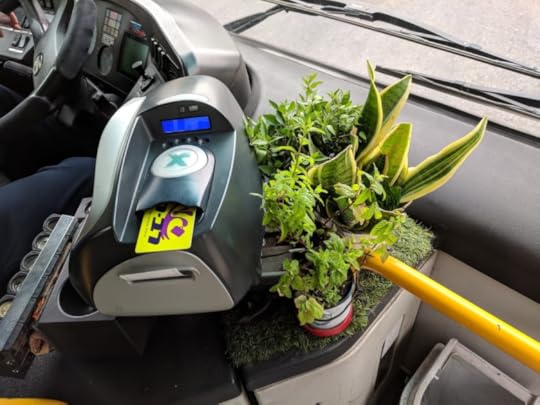 Rav Card Reader on a BusWe purchased a Rav Card, which connects all transportation. We paid a few sheckles each way for the train and a few for daily unlimited rides in Tel Aviv. The coast and the cities are places which are connected by mass transit. That is a good thing, because after driving our rental car in the congestion of Tel Aviv the first few days in Israel, I am glad to let someone else do the driving. After attempting to park in Haifa, I am glad to get off the bus, and not have to look for a place and walk up the hill back to our lodging.
Rav Card Reader on a BusWe purchased a Rav Card, which connects all transportation. We paid a few sheckles each way for the train and a few for daily unlimited rides in Tel Aviv. The coast and the cities are places which are connected by mass transit. That is a good thing, because after driving our rental car in the congestion of Tel Aviv the first few days in Israel, I am glad to let someone else do the driving. After attempting to park in Haifa, I am glad to get off the bus, and not have to look for a place and walk up the hill back to our lodging. 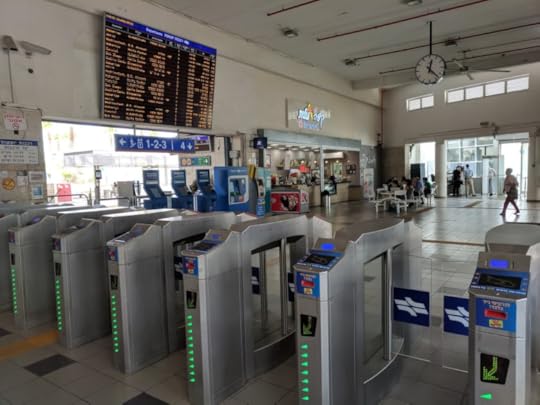 Entry to the Train StationThe drive down the coastal plain was beautiful. The ground is mostly level, but with some rock hills or desert sand dunes in places. There are a few rivers, swamps and lots of land which was drained a hundred years ago and is now used for agriculture. There are fields of cut grain, citrus groves, banana plantations and other farms along the plain. Before the nineteenth century, this land contained enough swampy areas that transportation could be controlled by fortresses.
Entry to the Train StationThe drive down the coastal plain was beautiful. The ground is mostly level, but with some rock hills or desert sand dunes in places. There are a few rivers, swamps and lots of land which was drained a hundred years ago and is now used for agriculture. There are fields of cut grain, citrus groves, banana plantations and other farms along the plain. Before the nineteenth century, this land contained enough swampy areas that transportation could be controlled by fortresses.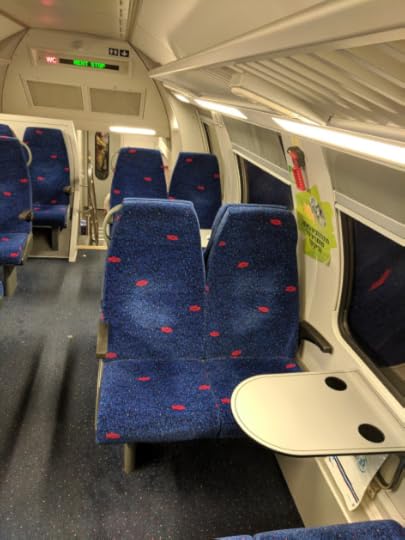 Comfortable interior of the Train CarThe train cars can be one level or two. Of course as a visitor to Israel, and because we like to look out the window, we go to the upper level (the morning train was only one level). The trains were crowded, and on the morning train I had to stand the full ride, of about an hour. Chelsea and I read some of Al-Khazari.
Comfortable interior of the Train CarThe train cars can be one level or two. Of course as a visitor to Israel, and because we like to look out the window, we go to the upper level (the morning train was only one level). The trains were crowded, and on the morning train I had to stand the full ride, of about an hour. Chelsea and I read some of Al-Khazari.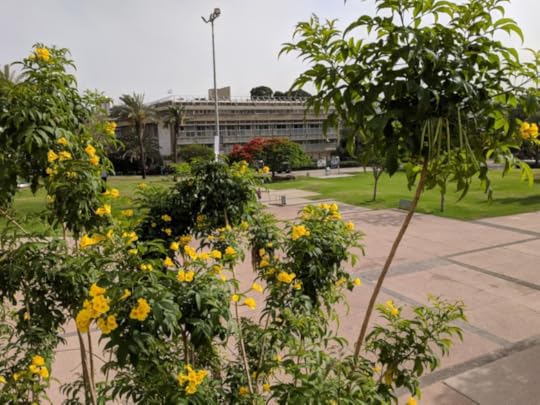 Flowers at Tel Aviv UniversityWe arrived in northern Tel Aviv and took the bus to Tel Aviv University. This is a large, multidisciplinary state college. Several museums on the campus afford visitors great experiences. We have visited the Eretz Israel and Palmach Museums in the past.
Flowers at Tel Aviv UniversityWe arrived in northern Tel Aviv and took the bus to Tel Aviv University. This is a large, multidisciplinary state college. Several museums on the campus afford visitors great experiences. We have visited the Eretz Israel and Palmach Museums in the past.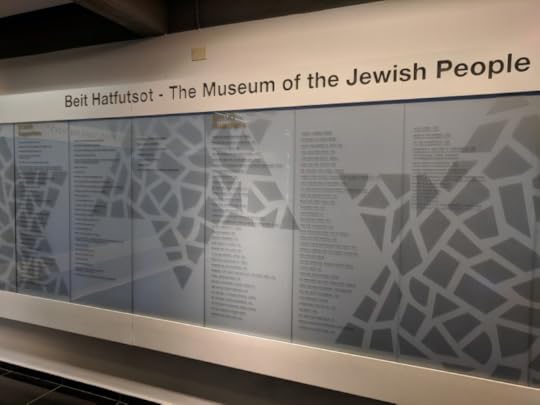 Museum of the Jewish People Yesterday we visited the Museum of the Jewish People. We enjoyed three different types of exhibits. The entry exhibit is on Jewish Humor. In the early 20th Century about 75% of the comedians in the United States were Jewish. Cultural humor comes from Eastern European communities where Jewish populations were congregated and often relate to the trials of our people.
Museum of the Jewish People Yesterday we visited the Museum of the Jewish People. We enjoyed three different types of exhibits. The entry exhibit is on Jewish Humor. In the early 20th Century about 75% of the comedians in the United States were Jewish. Cultural humor comes from Eastern European communities where Jewish populations were congregated and often relate to the trials of our people.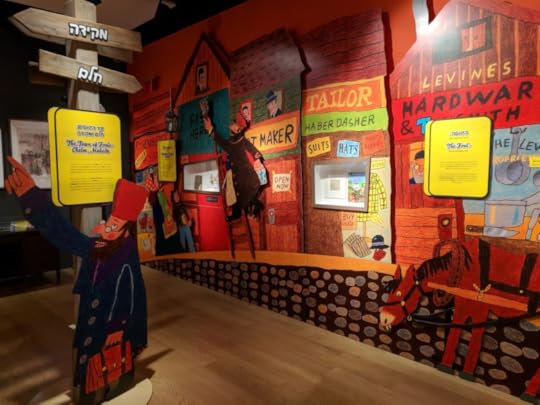 Museum of Jewish HumorOne source of Jewish humor is the Bible. There are many funny expressions in the Bible, and even books like Esther which are meant to provide relief in life through jest. The festival of Purim, built on the book of Esther, is totally about carnivals and fun.
Museum of Jewish HumorOne source of Jewish humor is the Bible. There are many funny expressions in the Bible, and even books like Esther which are meant to provide relief in life through jest. The festival of Purim, built on the book of Esther, is totally about carnivals and fun.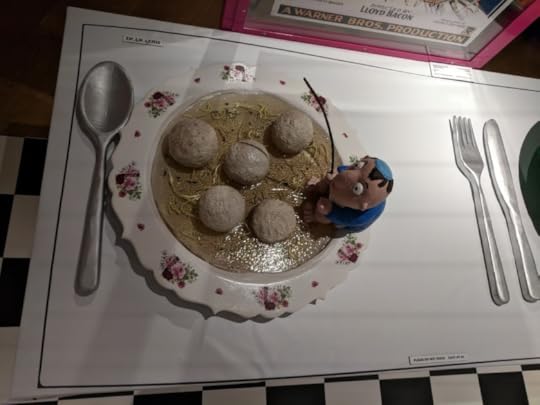 Fishing for Matzo Balls in SoupA second, more serious room in the museum was dedicated to places of worship. Detailed scale models, including interior rooms, were on display, showcasing major synagogues in Europe, the Middle East, and Asia.
Fishing for Matzo Balls in SoupA second, more serious room in the museum was dedicated to places of worship. Detailed scale models, including interior rooms, were on display, showcasing major synagogues in Europe, the Middle East, and Asia.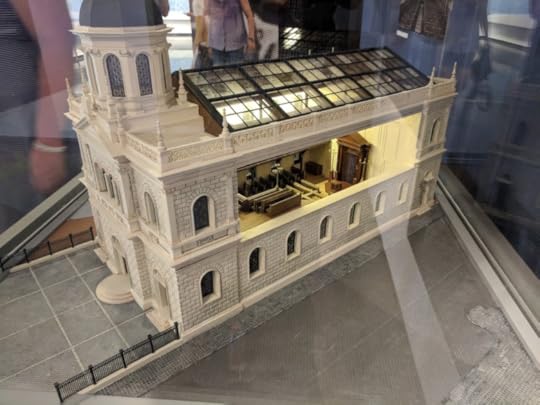 Synagogue in Vienna, AustriaThe Synagogue room also showed videos of Jewish worship.
Synagogue in Vienna, AustriaThe Synagogue room also showed videos of Jewish worship.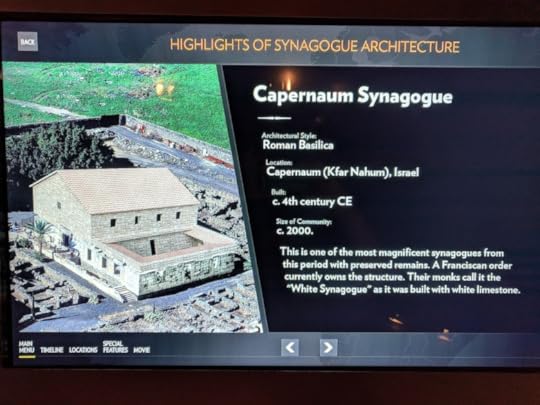 Capernaum SynagogueThe final room was on photography. It showed early photographs of Israel, and also photography from battle zones in Europe and Central America.
Capernaum SynagogueThe final room was on photography. It showed early photographs of Israel, and also photography from battle zones in Europe and Central America.
 Rav Card Reader on a BusWe purchased a Rav Card, which connects all transportation. We paid a few sheckles each way for the train and a few for daily unlimited rides in Tel Aviv. The coast and the cities are places which are connected by mass transit. That is a good thing, because after driving our rental car in the congestion of Tel Aviv the first few days in Israel, I am glad to let someone else do the driving. After attempting to park in Haifa, I am glad to get off the bus, and not have to look for a place and walk up the hill back to our lodging.
Rav Card Reader on a BusWe purchased a Rav Card, which connects all transportation. We paid a few sheckles each way for the train and a few for daily unlimited rides in Tel Aviv. The coast and the cities are places which are connected by mass transit. That is a good thing, because after driving our rental car in the congestion of Tel Aviv the first few days in Israel, I am glad to let someone else do the driving. After attempting to park in Haifa, I am glad to get off the bus, and not have to look for a place and walk up the hill back to our lodging.  Entry to the Train StationThe drive down the coastal plain was beautiful. The ground is mostly level, but with some rock hills or desert sand dunes in places. There are a few rivers, swamps and lots of land which was drained a hundred years ago and is now used for agriculture. There are fields of cut grain, citrus groves, banana plantations and other farms along the plain. Before the nineteenth century, this land contained enough swampy areas that transportation could be controlled by fortresses.
Entry to the Train StationThe drive down the coastal plain was beautiful. The ground is mostly level, but with some rock hills or desert sand dunes in places. There are a few rivers, swamps and lots of land which was drained a hundred years ago and is now used for agriculture. There are fields of cut grain, citrus groves, banana plantations and other farms along the plain. Before the nineteenth century, this land contained enough swampy areas that transportation could be controlled by fortresses. Comfortable interior of the Train CarThe train cars can be one level or two. Of course as a visitor to Israel, and because we like to look out the window, we go to the upper level (the morning train was only one level). The trains were crowded, and on the morning train I had to stand the full ride, of about an hour. Chelsea and I read some of Al-Khazari.
Comfortable interior of the Train CarThe train cars can be one level or two. Of course as a visitor to Israel, and because we like to look out the window, we go to the upper level (the morning train was only one level). The trains were crowded, and on the morning train I had to stand the full ride, of about an hour. Chelsea and I read some of Al-Khazari. Flowers at Tel Aviv UniversityWe arrived in northern Tel Aviv and took the bus to Tel Aviv University. This is a large, multidisciplinary state college. Several museums on the campus afford visitors great experiences. We have visited the Eretz Israel and Palmach Museums in the past.
Flowers at Tel Aviv UniversityWe arrived in northern Tel Aviv and took the bus to Tel Aviv University. This is a large, multidisciplinary state college. Several museums on the campus afford visitors great experiences. We have visited the Eretz Israel and Palmach Museums in the past. Museum of the Jewish People Yesterday we visited the Museum of the Jewish People. We enjoyed three different types of exhibits. The entry exhibit is on Jewish Humor. In the early 20th Century about 75% of the comedians in the United States were Jewish. Cultural humor comes from Eastern European communities where Jewish populations were congregated and often relate to the trials of our people.
Museum of the Jewish People Yesterday we visited the Museum of the Jewish People. We enjoyed three different types of exhibits. The entry exhibit is on Jewish Humor. In the early 20th Century about 75% of the comedians in the United States were Jewish. Cultural humor comes from Eastern European communities where Jewish populations were congregated and often relate to the trials of our people. Museum of Jewish HumorOne source of Jewish humor is the Bible. There are many funny expressions in the Bible, and even books like Esther which are meant to provide relief in life through jest. The festival of Purim, built on the book of Esther, is totally about carnivals and fun.
Museum of Jewish HumorOne source of Jewish humor is the Bible. There are many funny expressions in the Bible, and even books like Esther which are meant to provide relief in life through jest. The festival of Purim, built on the book of Esther, is totally about carnivals and fun. Fishing for Matzo Balls in SoupA second, more serious room in the museum was dedicated to places of worship. Detailed scale models, including interior rooms, were on display, showcasing major synagogues in Europe, the Middle East, and Asia.
Fishing for Matzo Balls in SoupA second, more serious room in the museum was dedicated to places of worship. Detailed scale models, including interior rooms, were on display, showcasing major synagogues in Europe, the Middle East, and Asia. Synagogue in Vienna, AustriaThe Synagogue room also showed videos of Jewish worship.
Synagogue in Vienna, AustriaThe Synagogue room also showed videos of Jewish worship. Capernaum SynagogueThe final room was on photography. It showed early photographs of Israel, and also photography from battle zones in Europe and Central America.
Capernaum SynagogueThe final room was on photography. It showed early photographs of Israel, and also photography from battle zones in Europe and Central America.
Published on May 22, 2018 22:26
May 21, 2018
Art in Haifa
Today’s journey began with an Israeli Breakfast. The food here is different. We did have scrambled eggs and a farmer’s omelet, but because this is Israel our fare also included a morning salad, Israeli salad, tuna salad, cream cheese, feta, olives, labnah and chickpeas, eggplant cream, tomato salsa with tahini, guacamole, yogurt with granola and honey, halva spread, fruit jam, butter and two small loaves of fresh, warm, whole-grain bread. We also ordered a regular shakshouka, and received coffees, water and juice.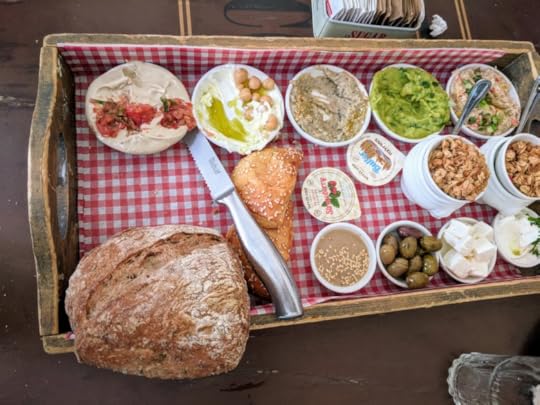 Breakfast for 2 includes a condiment trayAfter breakfast we went to Ulpan, Hebrew lessons for new Israelis. Because this new nation desires to incorporate all people into society, these classes are provided by the government for all new immigrants who desire to learn the Hebrew language. Why the Hebrew language?? Because it is the language of the Bible, so who would not want to learn.
Breakfast for 2 includes a condiment trayAfter breakfast we went to Ulpan, Hebrew lessons for new Israelis. Because this new nation desires to incorporate all people into society, these classes are provided by the government for all new immigrants who desire to learn the Hebrew language. Why the Hebrew language?? Because it is the language of the Bible, so who would not want to learn.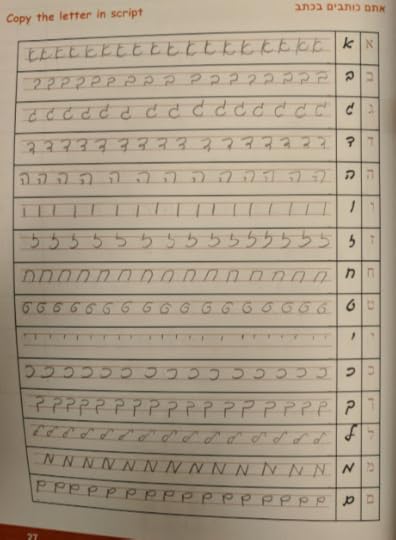 Ulpan teaches both block and cursive writingIn the afternoon we took a bus to the port area of Haifa to visit a museum (and cultural center), Beit Hagefen which sponsors an art project called Art Without Borders. The goal of the center is to develop good relations between Arabs, Jews and all other people.
Ulpan teaches both block and cursive writingIn the afternoon we took a bus to the port area of Haifa to visit a museum (and cultural center), Beit Hagefen which sponsors an art project called Art Without Borders. The goal of the center is to develop good relations between Arabs, Jews and all other people. 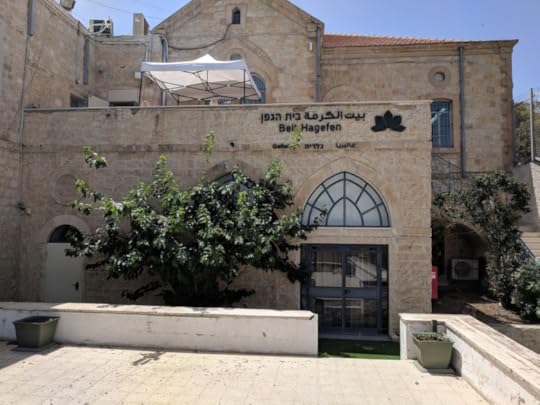 The cultural center includes two or three buildingsThe organization uses the arts to bring people together. They have a theater where they produce dramas.
The cultural center includes two or three buildingsThe organization uses the arts to bring people together. They have a theater where they produce dramas.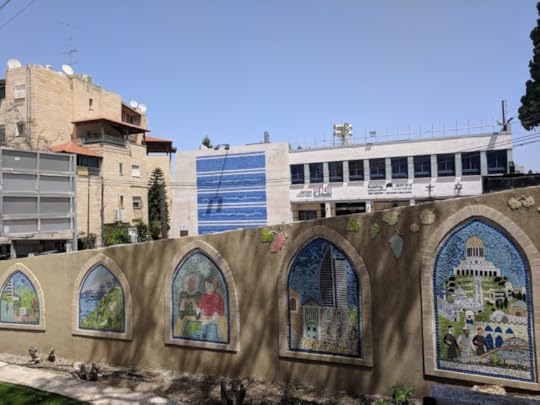 The mosaics were given during the 'Holiday of Holidays'They also enable artists to place work throughout the neighborhood that surrounds the Beit Hagefen center.
The mosaics were given during the 'Holiday of Holidays'They also enable artists to place work throughout the neighborhood that surrounds the Beit Hagefen center.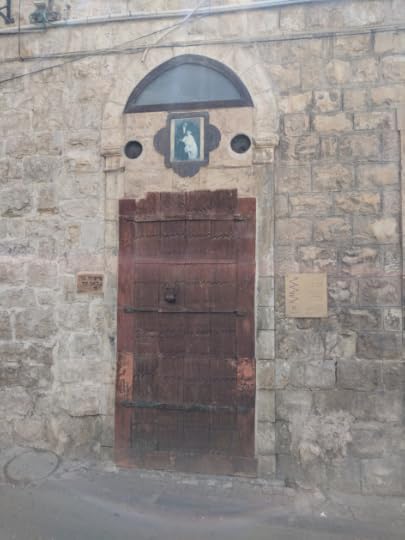 An artist celebrates a family that lived in the neighborhood for several generations.The area surrounding the cultural center is the oldest in Haifa. It contains a mixture of Arabs, Jews, Bahai and Christians.
An artist celebrates a family that lived in the neighborhood for several generations.The area surrounding the cultural center is the oldest in Haifa. It contains a mixture of Arabs, Jews, Bahai and Christians.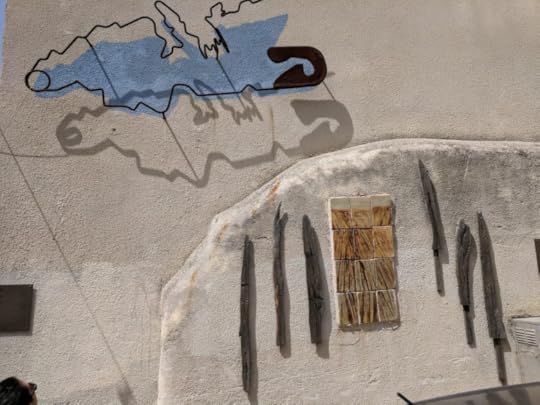 This artist will return to close the Mediterranean shaped safety pin when there is peace!The art museum is without borders because artwork is placed on homes in the neighborhood.
This artist will return to close the Mediterranean shaped safety pin when there is peace!The art museum is without borders because artwork is placed on homes in the neighborhood.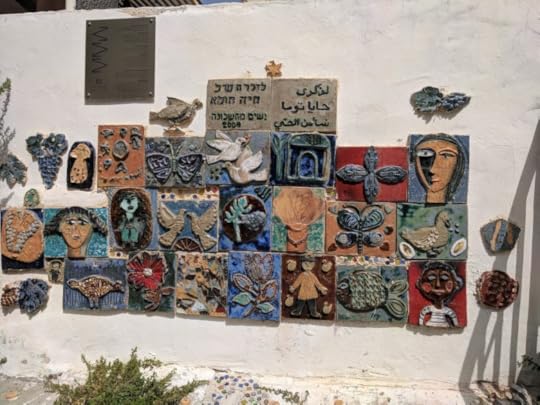 Artwork from all cultures to promote living together in peaceEach piece attempts to bring factions of people together and build peace.
Artwork from all cultures to promote living together in peaceEach piece attempts to bring factions of people together and build peace.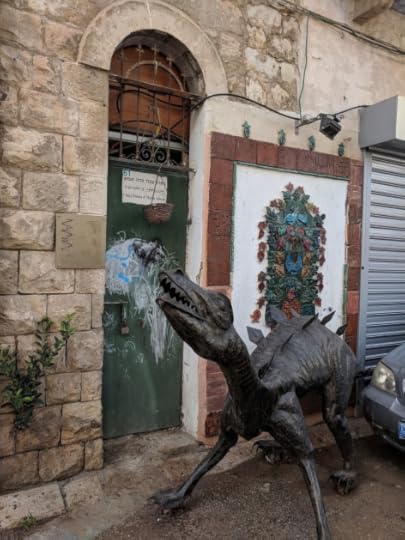 The Dinosaur is a moving exhibitHorizon says in the exchange between the Hooves and Grass,“The Hooves will not have the last word / Through the succession of the seasons,Spring will always make the grass green,/ as generations come and go.”Echo says, “I wish to be the hooves, not the forlorn grass./ I loathe the blessed lowliness / and the kindness of feeble sympathy / I wish to be the hooves / not the sturdy grass.”Horizon says, “You realize that hooves are the shoes of horses!”Echo says, “All the grass is the insole of the horses’ shoes”Horizon adds: “Likewise, the spurs are the insoles of the knights / to be lunged into horses’ soft waist!”Echo insists: “I would rather be the hooves than the sturdy grass!”Horizon says: “And you would not mind the snake-like image of the victim's face eternally poised on your chest?”Bewildered Echo fell silent! in the horses’
The Dinosaur is a moving exhibitHorizon says in the exchange between the Hooves and Grass,“The Hooves will not have the last word / Through the succession of the seasons,Spring will always make the grass green,/ as generations come and go.”Echo says, “I wish to be the hooves, not the forlorn grass./ I loathe the blessed lowliness / and the kindness of feeble sympathy / I wish to be the hooves / not the sturdy grass.”Horizon says, “You realize that hooves are the shoes of horses!”Echo says, “All the grass is the insole of the horses’ shoes”Horizon adds: “Likewise, the spurs are the insoles of the knights / to be lunged into horses’ soft waist!”Echo insists: “I would rather be the hooves than the sturdy grass!”Horizon says: “And you would not mind the snake-like image of the victim's face eternally poised on your chest?”Bewildered Echo fell silent! in the horses’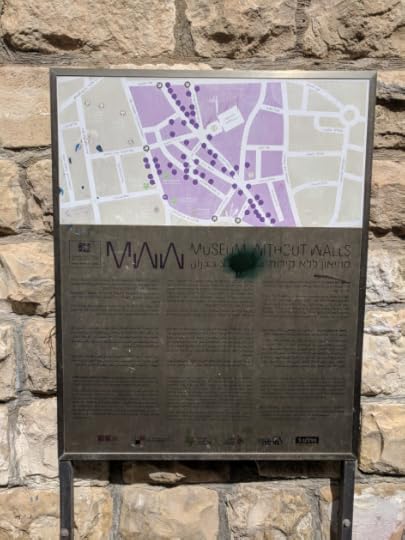 Many pieces of art are located throughout the neighborhoodThe artwork is scattered around a vibrant neighborhood filled with people and small shops,
Many pieces of art are located throughout the neighborhoodThe artwork is scattered around a vibrant neighborhood filled with people and small shops, 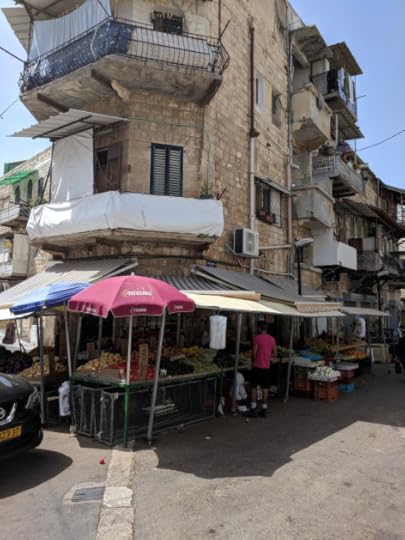 The vegetables are always fresh at these markets
The vegetables are always fresh at these markets
Such as vegetable stands and bakery outlets.
 Breakfast for 2 includes a condiment trayAfter breakfast we went to Ulpan, Hebrew lessons for new Israelis. Because this new nation desires to incorporate all people into society, these classes are provided by the government for all new immigrants who desire to learn the Hebrew language. Why the Hebrew language?? Because it is the language of the Bible, so who would not want to learn.
Breakfast for 2 includes a condiment trayAfter breakfast we went to Ulpan, Hebrew lessons for new Israelis. Because this new nation desires to incorporate all people into society, these classes are provided by the government for all new immigrants who desire to learn the Hebrew language. Why the Hebrew language?? Because it is the language of the Bible, so who would not want to learn. Ulpan teaches both block and cursive writingIn the afternoon we took a bus to the port area of Haifa to visit a museum (and cultural center), Beit Hagefen which sponsors an art project called Art Without Borders. The goal of the center is to develop good relations between Arabs, Jews and all other people.
Ulpan teaches both block and cursive writingIn the afternoon we took a bus to the port area of Haifa to visit a museum (and cultural center), Beit Hagefen which sponsors an art project called Art Without Borders. The goal of the center is to develop good relations between Arabs, Jews and all other people.  The cultural center includes two or three buildingsThe organization uses the arts to bring people together. They have a theater where they produce dramas.
The cultural center includes two or three buildingsThe organization uses the arts to bring people together. They have a theater where they produce dramas. The mosaics were given during the 'Holiday of Holidays'They also enable artists to place work throughout the neighborhood that surrounds the Beit Hagefen center.
The mosaics were given during the 'Holiday of Holidays'They also enable artists to place work throughout the neighborhood that surrounds the Beit Hagefen center. An artist celebrates a family that lived in the neighborhood for several generations.The area surrounding the cultural center is the oldest in Haifa. It contains a mixture of Arabs, Jews, Bahai and Christians.
An artist celebrates a family that lived in the neighborhood for several generations.The area surrounding the cultural center is the oldest in Haifa. It contains a mixture of Arabs, Jews, Bahai and Christians. This artist will return to close the Mediterranean shaped safety pin when there is peace!The art museum is without borders because artwork is placed on homes in the neighborhood.
This artist will return to close the Mediterranean shaped safety pin when there is peace!The art museum is without borders because artwork is placed on homes in the neighborhood. Artwork from all cultures to promote living together in peaceEach piece attempts to bring factions of people together and build peace.
Artwork from all cultures to promote living together in peaceEach piece attempts to bring factions of people together and build peace. The Dinosaur is a moving exhibitHorizon says in the exchange between the Hooves and Grass,“The Hooves will not have the last word / Through the succession of the seasons,Spring will always make the grass green,/ as generations come and go.”Echo says, “I wish to be the hooves, not the forlorn grass./ I loathe the blessed lowliness / and the kindness of feeble sympathy / I wish to be the hooves / not the sturdy grass.”Horizon says, “You realize that hooves are the shoes of horses!”Echo says, “All the grass is the insole of the horses’ shoes”Horizon adds: “Likewise, the spurs are the insoles of the knights / to be lunged into horses’ soft waist!”Echo insists: “I would rather be the hooves than the sturdy grass!”Horizon says: “And you would not mind the snake-like image of the victim's face eternally poised on your chest?”Bewildered Echo fell silent! in the horses’
The Dinosaur is a moving exhibitHorizon says in the exchange between the Hooves and Grass,“The Hooves will not have the last word / Through the succession of the seasons,Spring will always make the grass green,/ as generations come and go.”Echo says, “I wish to be the hooves, not the forlorn grass./ I loathe the blessed lowliness / and the kindness of feeble sympathy / I wish to be the hooves / not the sturdy grass.”Horizon says, “You realize that hooves are the shoes of horses!”Echo says, “All the grass is the insole of the horses’ shoes”Horizon adds: “Likewise, the spurs are the insoles of the knights / to be lunged into horses’ soft waist!”Echo insists: “I would rather be the hooves than the sturdy grass!”Horizon says: “And you would not mind the snake-like image of the victim's face eternally poised on your chest?”Bewildered Echo fell silent! in the horses’ Many pieces of art are located throughout the neighborhoodThe artwork is scattered around a vibrant neighborhood filled with people and small shops,
Many pieces of art are located throughout the neighborhoodThe artwork is scattered around a vibrant neighborhood filled with people and small shops,  The vegetables are always fresh at these markets
The vegetables are always fresh at these marketsSuch as vegetable stands and bakery outlets.
Published on May 21, 2018 20:02
A Garden for the Bab
Today’s hike took me to the Baha’i Gardens a beautiful garden in Haifa which spreads from the bottom to the top of Mount Carmel. The green space which is enjoyed today by thousands began with vegetable plantings in the early 1900’s. Baha’u’llah, the chief prophet of the Baha’i faith shared dreams of something more while he was still alive. In 1987, Canadian Fariborz Sabba stepped forward with plans for today’s beautiful place of meditation, and the garden which is seen today was soon created.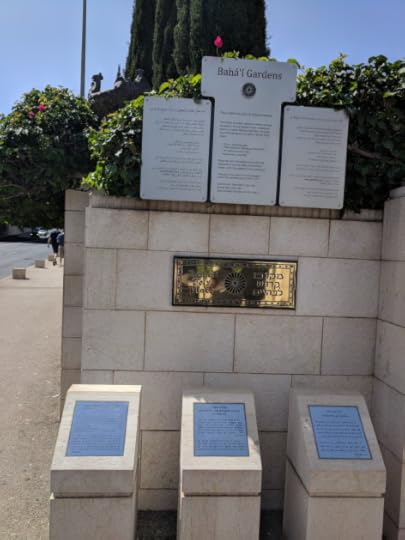 Two entrances to the garden exist on top of Mount Carmel. The most obvious is only an observation point. All who wish to enjoy can walk down one level in order to enjoy a bit of quiet and a phenomenal view through the middle of the garden from top to bottom.
Two entrances to the garden exist on top of Mount Carmel. The most obvious is only an observation point. All who wish to enjoy can walk down one level in order to enjoy a bit of quiet and a phenomenal view through the middle of the garden from top to bottom.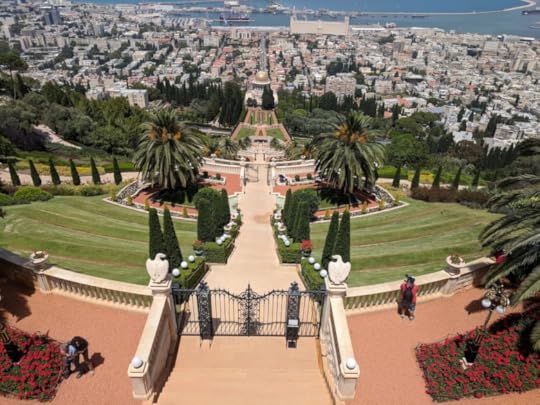 About a hundred meters west of the central terrace the Baha’i offer free guided tours through the garden. Most tours are in Hebrew, but if most (or all) of the participants on a tour speak English, the guide will give the tour according to preference.
About a hundred meters west of the central terrace the Baha’i offer free guided tours through the garden. Most tours are in Hebrew, but if most (or all) of the participants on a tour speak English, the guide will give the tour according to preference.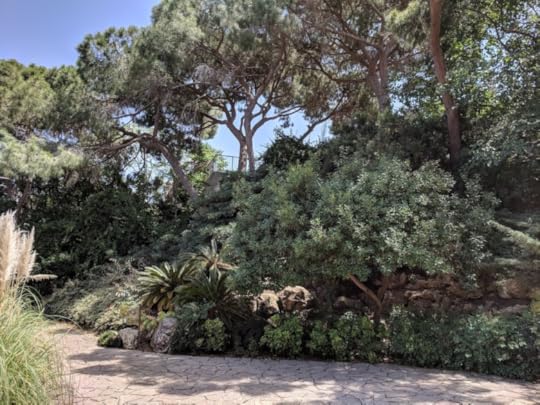 The waiting area for the tour contains several succulents, aloe, pines, cacti, pampas grass, and various flowers.
The waiting area for the tour contains several succulents, aloe, pines, cacti, pampas grass, and various flowers.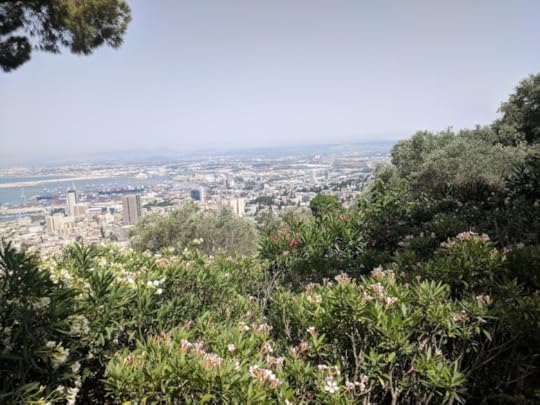 The guide takes guests down several levels at a time, giving a lecture at appointed areas, where there is shade. He tells the history of the garden and the history of the church.
The guide takes guests down several levels at a time, giving a lecture at appointed areas, where there is shade. He tells the history of the garden and the history of the church.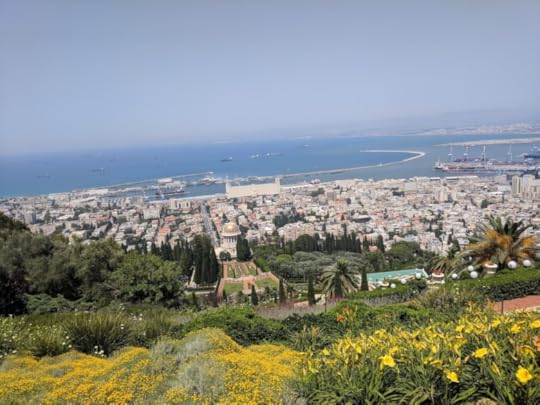 The terraces on each level contain similarities, but are different. There are palm trees, fountains and bronze peacocks. On some terraces they are at rest, on others their tail feathers are spread in display.
The terraces on each level contain similarities, but are different. There are palm trees, fountains and bronze peacocks. On some terraces they are at rest, on others their tail feathers are spread in display.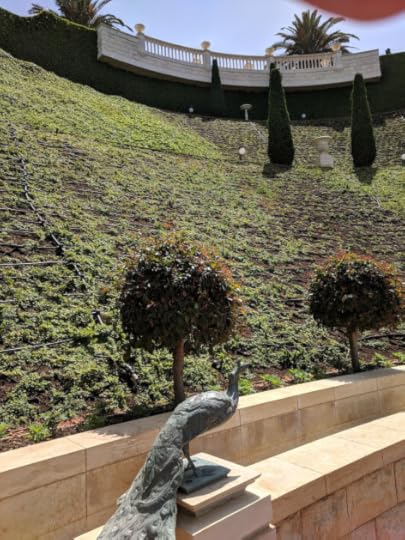 The birds, plantings and fountains are not religious objects, only items of beauty. Baha’u’llah and the Bab enjoyed were admirers of the beauty which God created across the earth.
The birds, plantings and fountains are not religious objects, only items of beauty. Baha’u’llah and the Bab enjoyed were admirers of the beauty which God created across the earth.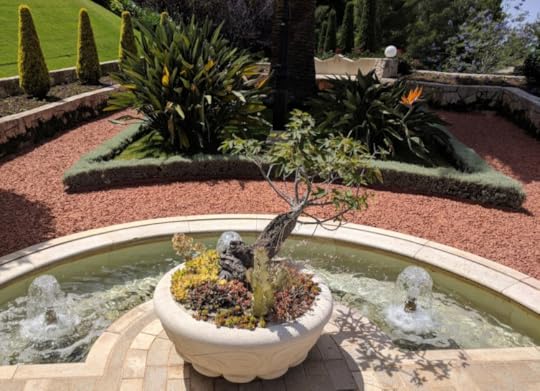 The Baha’i faith began with the teachings of the Bab, born as Siyyid ‘Ali Mohammad in 1819. When yet a young merchant of Persia in 1844, he announced that he received a vision, sent by God, to prepare mankind for a new era and the imminent appearance of a Messenger greater than himself.
The Baha’i faith began with the teachings of the Bab, born as Siyyid ‘Ali Mohammad in 1819. When yet a young merchant of Persia in 1844, he announced that he received a vision, sent by God, to prepare mankind for a new era and the imminent appearance of a Messenger greater than himself.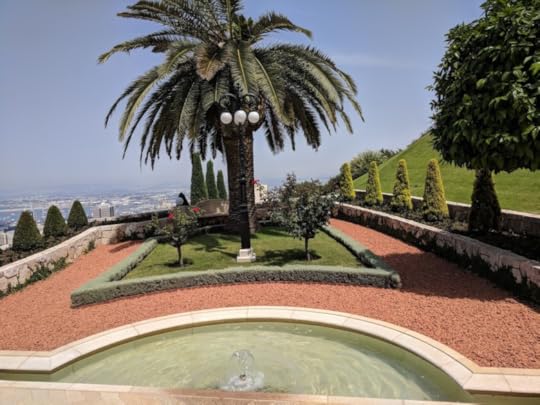 At a time when equality, unity of religions and peace were not commonly accepted, the Bab pushed these values in an Islamic world. Within the first year he had eighteen followers, and the movement grew. The Bab told the faithful that he was a herald, and his mission was to announce a coming teacher. He was rejected and martyred in 1850. His body was thrown outside the city without a burial, but his followers retrieved the corpse and hid it away, trusting there would be a time the Bab would receive a proper burial.
At a time when equality, unity of religions and peace were not commonly accepted, the Bab pushed these values in an Islamic world. Within the first year he had eighteen followers, and the movement grew. The Bab told the faithful that he was a herald, and his mission was to announce a coming teacher. He was rejected and martyred in 1850. His body was thrown outside the city without a burial, but his followers retrieved the corpse and hid it away, trusting there would be a time the Bab would receive a proper burial.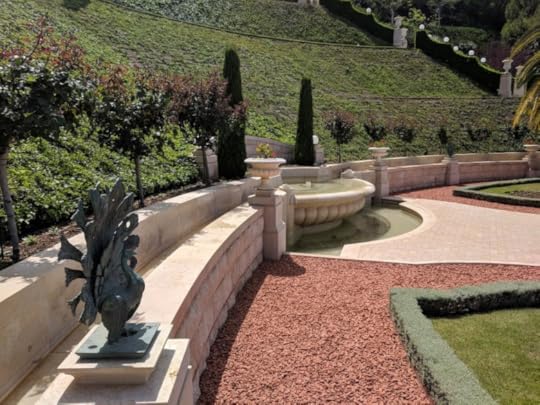 Baha’u’llah, born Mirza Husayn-’Ali in 1817, was the son of a Persian nobleman. His assumed name means “the Glory of God,” and he continued proclaiming the teachings of the Bab more forcefully, and drew more followers.
Baha’u’llah, born Mirza Husayn-’Ali in 1817, was the son of a Persian nobleman. His assumed name means “the Glory of God,” and he continued proclaiming the teachings of the Bab more forcefully, and drew more followers. 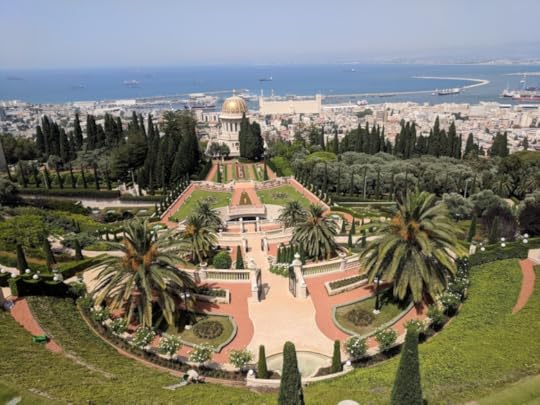 Baha’u’llah could not be killed, because of the power of his father, so he was imprisoned in Baghdad. While in jail he continued to preach, drawing inmates and guards to his new faith. He also shouted out the windows of his cell and reached drew many followers from the city.
Baha’u’llah could not be killed, because of the power of his father, so he was imprisoned in Baghdad. While in jail he continued to preach, drawing inmates and guards to his new faith. He also shouted out the windows of his cell and reached drew many followers from the city.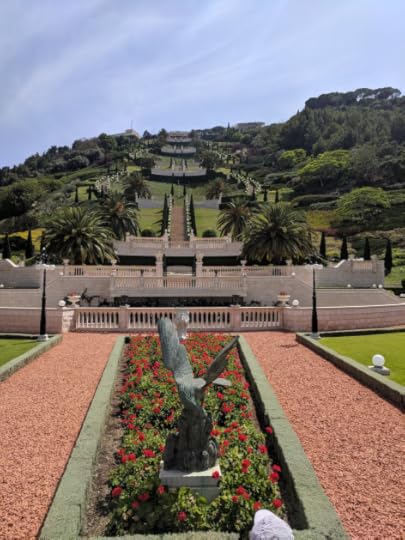 He was sent away to Constantinople and then to Akko where others followed the movement. He gained favor of his jailor and the local governor, who soon allowed him to travel about.
He was sent away to Constantinople and then to Akko where others followed the movement. He gained favor of his jailor and the local governor, who soon allowed him to travel about.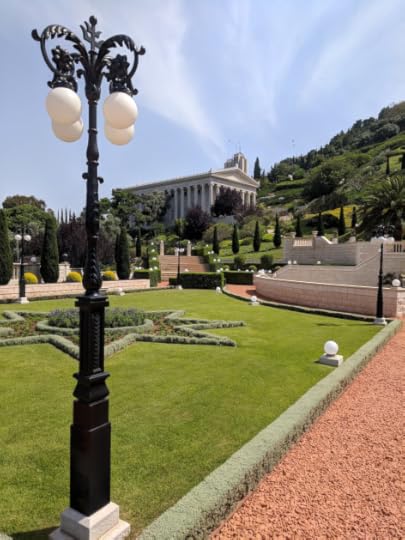 He redeemed the body of the Bab, and buried it in Haifa. He also shared the dream of building a garden around the tomb as a place for people to meditate. The garden was completed in the late 20th century, and people come from across the globe to enjoy its beauty.
He redeemed the body of the Bab, and buried it in Haifa. He also shared the dream of building a garden around the tomb as a place for people to meditate. The garden was completed in the late 20th century, and people come from across the globe to enjoy its beauty.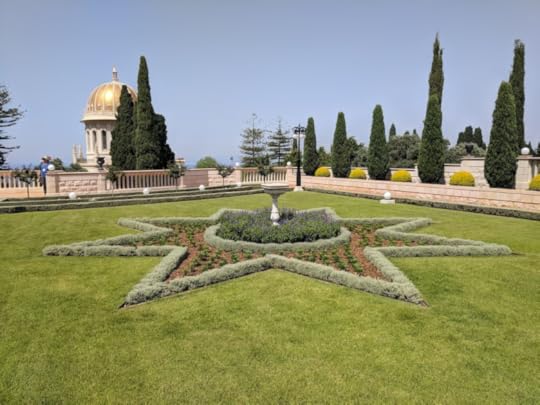 The gardens contai the gold domed tomb of the Bab, a Universal House of Justice fro which members of the Baha'i faith are ruled, a center for study of the original texts of the Baha'i faith, and a teaching center.
The gardens contai the gold domed tomb of the Bab, a Universal House of Justice fro which members of the Baha'i faith are ruled, a center for study of the original texts of the Baha'i faith, and a teaching center. 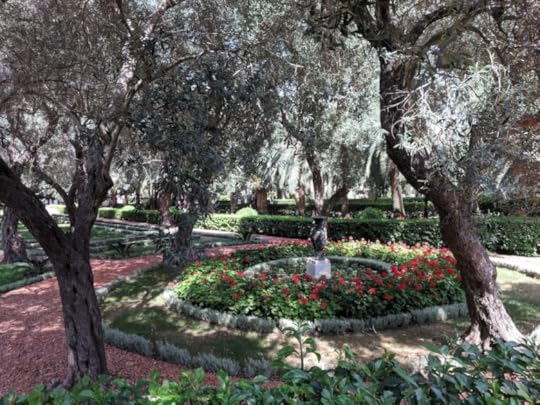 The archives are built in a manner identical to the Parthenon in Greece, and of the same marble.
The archives are built in a manner identical to the Parthenon in Greece, and of the same marble. 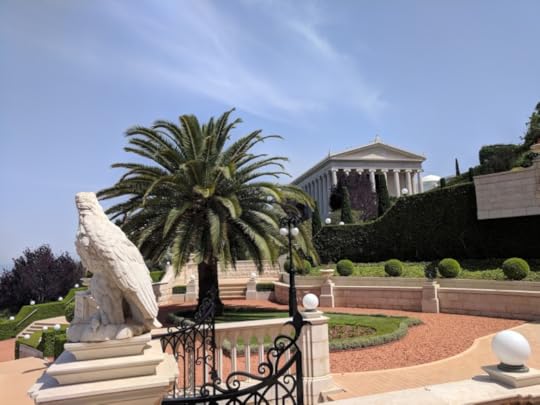
The Bahai teach that their mission is to combine all faiths of the world into one body. They are rejected by other religious groups because there are inconsistencies which will not allow unity between world religions.
 Two entrances to the garden exist on top of Mount Carmel. The most obvious is only an observation point. All who wish to enjoy can walk down one level in order to enjoy a bit of quiet and a phenomenal view through the middle of the garden from top to bottom.
Two entrances to the garden exist on top of Mount Carmel. The most obvious is only an observation point. All who wish to enjoy can walk down one level in order to enjoy a bit of quiet and a phenomenal view through the middle of the garden from top to bottom. About a hundred meters west of the central terrace the Baha’i offer free guided tours through the garden. Most tours are in Hebrew, but if most (or all) of the participants on a tour speak English, the guide will give the tour according to preference.
About a hundred meters west of the central terrace the Baha’i offer free guided tours through the garden. Most tours are in Hebrew, but if most (or all) of the participants on a tour speak English, the guide will give the tour according to preference. The waiting area for the tour contains several succulents, aloe, pines, cacti, pampas grass, and various flowers.
The waiting area for the tour contains several succulents, aloe, pines, cacti, pampas grass, and various flowers. The guide takes guests down several levels at a time, giving a lecture at appointed areas, where there is shade. He tells the history of the garden and the history of the church.
The guide takes guests down several levels at a time, giving a lecture at appointed areas, where there is shade. He tells the history of the garden and the history of the church. The terraces on each level contain similarities, but are different. There are palm trees, fountains and bronze peacocks. On some terraces they are at rest, on others their tail feathers are spread in display.
The terraces on each level contain similarities, but are different. There are palm trees, fountains and bronze peacocks. On some terraces they are at rest, on others their tail feathers are spread in display. The birds, plantings and fountains are not religious objects, only items of beauty. Baha’u’llah and the Bab enjoyed were admirers of the beauty which God created across the earth.
The birds, plantings and fountains are not religious objects, only items of beauty. Baha’u’llah and the Bab enjoyed were admirers of the beauty which God created across the earth. The Baha’i faith began with the teachings of the Bab, born as Siyyid ‘Ali Mohammad in 1819. When yet a young merchant of Persia in 1844, he announced that he received a vision, sent by God, to prepare mankind for a new era and the imminent appearance of a Messenger greater than himself.
The Baha’i faith began with the teachings of the Bab, born as Siyyid ‘Ali Mohammad in 1819. When yet a young merchant of Persia in 1844, he announced that he received a vision, sent by God, to prepare mankind for a new era and the imminent appearance of a Messenger greater than himself. At a time when equality, unity of religions and peace were not commonly accepted, the Bab pushed these values in an Islamic world. Within the first year he had eighteen followers, and the movement grew. The Bab told the faithful that he was a herald, and his mission was to announce a coming teacher. He was rejected and martyred in 1850. His body was thrown outside the city without a burial, but his followers retrieved the corpse and hid it away, trusting there would be a time the Bab would receive a proper burial.
At a time when equality, unity of religions and peace were not commonly accepted, the Bab pushed these values in an Islamic world. Within the first year he had eighteen followers, and the movement grew. The Bab told the faithful that he was a herald, and his mission was to announce a coming teacher. He was rejected and martyred in 1850. His body was thrown outside the city without a burial, but his followers retrieved the corpse and hid it away, trusting there would be a time the Bab would receive a proper burial. Baha’u’llah, born Mirza Husayn-’Ali in 1817, was the son of a Persian nobleman. His assumed name means “the Glory of God,” and he continued proclaiming the teachings of the Bab more forcefully, and drew more followers.
Baha’u’llah, born Mirza Husayn-’Ali in 1817, was the son of a Persian nobleman. His assumed name means “the Glory of God,” and he continued proclaiming the teachings of the Bab more forcefully, and drew more followers.  Baha’u’llah could not be killed, because of the power of his father, so he was imprisoned in Baghdad. While in jail he continued to preach, drawing inmates and guards to his new faith. He also shouted out the windows of his cell and reached drew many followers from the city.
Baha’u’llah could not be killed, because of the power of his father, so he was imprisoned in Baghdad. While in jail he continued to preach, drawing inmates and guards to his new faith. He also shouted out the windows of his cell and reached drew many followers from the city. He was sent away to Constantinople and then to Akko where others followed the movement. He gained favor of his jailor and the local governor, who soon allowed him to travel about.
He was sent away to Constantinople and then to Akko where others followed the movement. He gained favor of his jailor and the local governor, who soon allowed him to travel about. He redeemed the body of the Bab, and buried it in Haifa. He also shared the dream of building a garden around the tomb as a place for people to meditate. The garden was completed in the late 20th century, and people come from across the globe to enjoy its beauty.
He redeemed the body of the Bab, and buried it in Haifa. He also shared the dream of building a garden around the tomb as a place for people to meditate. The garden was completed in the late 20th century, and people come from across the globe to enjoy its beauty. The gardens contai the gold domed tomb of the Bab, a Universal House of Justice fro which members of the Baha'i faith are ruled, a center for study of the original texts of the Baha'i faith, and a teaching center.
The gardens contai the gold domed tomb of the Bab, a Universal House of Justice fro which members of the Baha'i faith are ruled, a center for study of the original texts of the Baha'i faith, and a teaching center.  The archives are built in a manner identical to the Parthenon in Greece, and of the same marble.
The archives are built in a manner identical to the Parthenon in Greece, and of the same marble. 
The Bahai teach that their mission is to combine all faiths of the world into one body. They are rejected by other religious groups because there are inconsistencies which will not allow unity between world religions.
Published on May 21, 2018 03:54
May 19, 2018
Shavuot, A Summer Festival
Today is Shavuot, the summer harvest festival celebrated in Israel from antiquity. God told Moses to command the Hebrews, “Count off seven weeks from the time you begin to put the sickle to the standing grain. Then celebrate the Festival of Weeks to the Lord your God by giving a freewill offering in proportion to the blessings the Lord your God has given you. And rejoice before the Lord your God at the place he will choose as a dwelling for his Name.” (Deut. 16:9-11)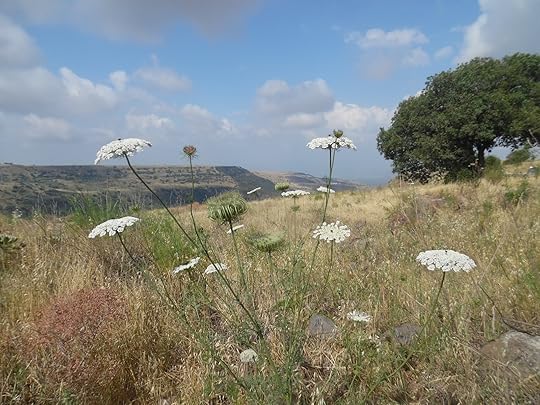 Flowers in the Golan
Flowers in the Golan
The Jews have taken this celebration as a time as an opportunity for thanksgiving, remembering that God is the provider of all good things. Children wear wreaths of flowers around their heads to celebrate the beauty of nature during the days leading up to the festival of weeks. Christians, without realizing it, count the omer and call the day of first fruits Pentecost.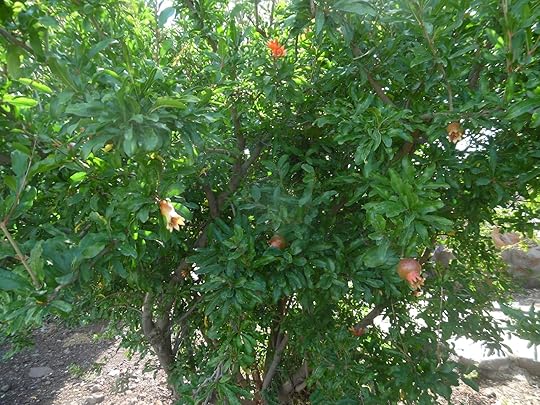 Pomegranate Tree with flowers and young fruitThe Mishnah relates that before the destruction of the Temple in 70 AD, the Festival of First Fruits was a community gala when people of Eretz Yisrael (the land of Israel) would make a pilgrimage to the Temple in Jerusalem bringing an offering from their agricultural produce at the time of their local harvest.
Pomegranate Tree with flowers and young fruitThe Mishnah relates that before the destruction of the Temple in 70 AD, the Festival of First Fruits was a community gala when people of Eretz Yisrael (the land of Israel) would make a pilgrimage to the Temple in Jerusalem bringing an offering from their agricultural produce at the time of their local harvest.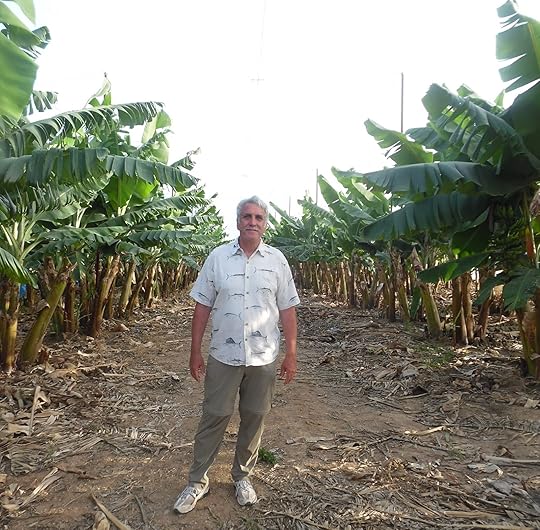 Banana Plantation in GalileeA local official would cry out on the day after the first harvest in each local community, “Rise and let us go up to Zion, to the House of the Lord our God.”
Banana Plantation in GalileeA local official would cry out on the day after the first harvest in each local community, “Rise and let us go up to Zion, to the House of the Lord our God.”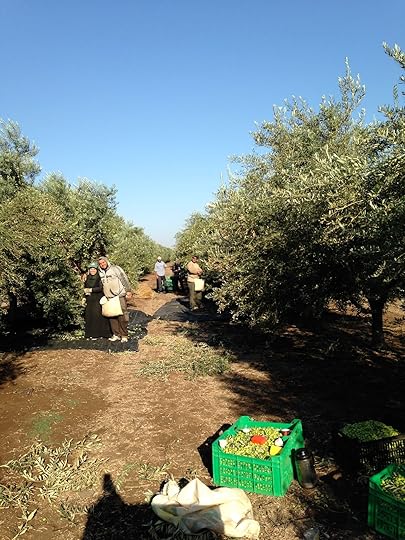 Olive Harvest in IsraelThe offering of first fruits would be placed on a cart, drawn by an ox which was decorated for the occasion. Its horns were covered with gold, an olive crown was placed on its head, and fruits and wreaths adorned its back and the cart.
Olive Harvest in IsraelThe offering of first fruits would be placed on a cart, drawn by an ox which was decorated for the occasion. Its horns were covered with gold, an olive crown was placed on its head, and fruits and wreaths adorned its back and the cart. 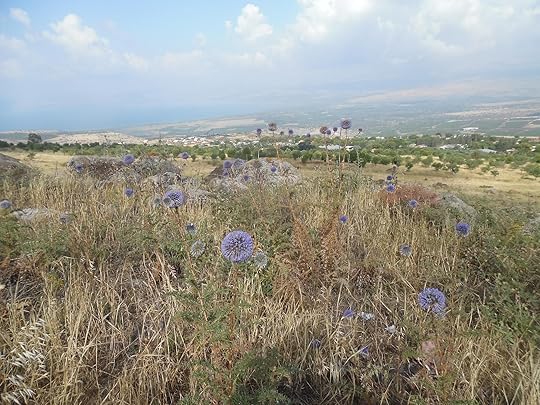 Flowers in GolanThe local official and a musician who played the halil (flute) would lead a procession, followed by the decorated ox who pulled the cart, which was followed by the people of the community until they reached the vicinity of Jerusalem. Along the road a team of greeters would join the procession and enlarge the music and joy of the celebration until the entire procession reached the gates of the city.
Flowers in GolanThe local official and a musician who played the halil (flute) would lead a procession, followed by the decorated ox who pulled the cart, which was followed by the people of the community until they reached the vicinity of Jerusalem. Along the road a team of greeters would join the procession and enlarge the music and joy of the celebration until the entire procession reached the gates of the city. 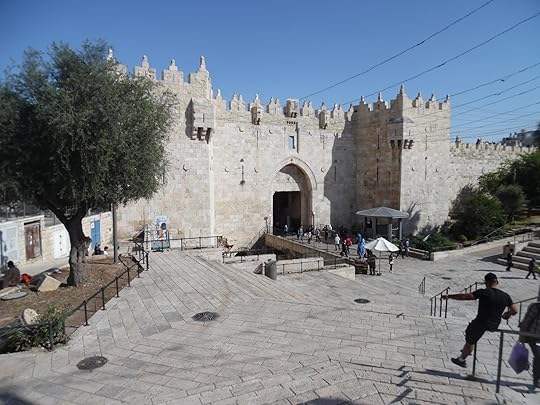 Damascus Gate, a main entry into Jerusalem from the northAt the gates of Jerusalem an important official met the procession and led them to Temple Mount. Along the streets of the city tradesmen would greet them with a welcome of peace, with singing, and probably with encouragement to examine their wares as the procession left town.
Damascus Gate, a main entry into Jerusalem from the northAt the gates of Jerusalem an important official met the procession and led them to Temple Mount. Along the streets of the city tradesmen would greet them with a welcome of peace, with singing, and probably with encouragement to examine their wares as the procession left town.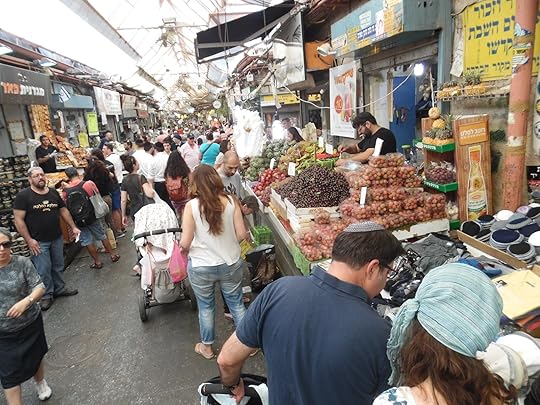 The Shuk, Mahane Yehuda MarketFollowing the destruction of the Temple, the Jewish people were faced with the dilemma as to how God should be honored without a designated meeting place to honor The Name. Rabbi Meir suggested (Exodus Rabbah, chapter 31) that the festival should be celebrated as the day the Torah was given on Mount Sinai. It has been noted that this event occurred about three months after Passover, which preceded the exodus from Egypt.
The Shuk, Mahane Yehuda MarketFollowing the destruction of the Temple, the Jewish people were faced with the dilemma as to how God should be honored without a designated meeting place to honor The Name. Rabbi Meir suggested (Exodus Rabbah, chapter 31) that the festival should be celebrated as the day the Torah was given on Mount Sinai. It has been noted that this event occurred about three months after Passover, which preceded the exodus from Egypt.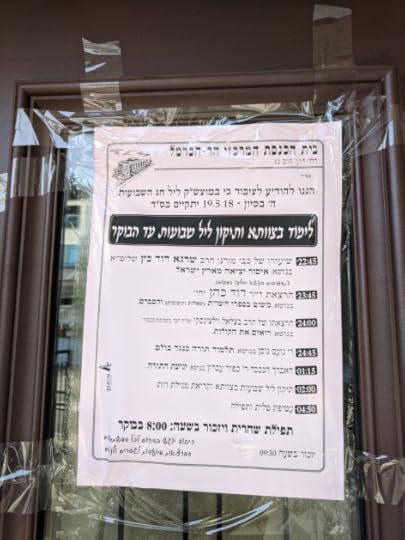 Shavuot Program in HaifaIn response, many Jews have added an all night study of Torah to the celebration of Shavuot. They also encourage partaking of dairy products (such as ice cream and cheesecake) to enhance the celebration.
Shavuot Program in HaifaIn response, many Jews have added an all night study of Torah to the celebration of Shavuot. They also encourage partaking of dairy products (such as ice cream and cheesecake) to enhance the celebration.
 Flowers in the Golan
Flowers in the GolanThe Jews have taken this celebration as a time as an opportunity for thanksgiving, remembering that God is the provider of all good things. Children wear wreaths of flowers around their heads to celebrate the beauty of nature during the days leading up to the festival of weeks. Christians, without realizing it, count the omer and call the day of first fruits Pentecost.
 Pomegranate Tree with flowers and young fruitThe Mishnah relates that before the destruction of the Temple in 70 AD, the Festival of First Fruits was a community gala when people of Eretz Yisrael (the land of Israel) would make a pilgrimage to the Temple in Jerusalem bringing an offering from their agricultural produce at the time of their local harvest.
Pomegranate Tree with flowers and young fruitThe Mishnah relates that before the destruction of the Temple in 70 AD, the Festival of First Fruits was a community gala when people of Eretz Yisrael (the land of Israel) would make a pilgrimage to the Temple in Jerusalem bringing an offering from their agricultural produce at the time of their local harvest. Banana Plantation in GalileeA local official would cry out on the day after the first harvest in each local community, “Rise and let us go up to Zion, to the House of the Lord our God.”
Banana Plantation in GalileeA local official would cry out on the day after the first harvest in each local community, “Rise and let us go up to Zion, to the House of the Lord our God.” Olive Harvest in IsraelThe offering of first fruits would be placed on a cart, drawn by an ox which was decorated for the occasion. Its horns were covered with gold, an olive crown was placed on its head, and fruits and wreaths adorned its back and the cart.
Olive Harvest in IsraelThe offering of first fruits would be placed on a cart, drawn by an ox which was decorated for the occasion. Its horns were covered with gold, an olive crown was placed on its head, and fruits and wreaths adorned its back and the cart.  Flowers in GolanThe local official and a musician who played the halil (flute) would lead a procession, followed by the decorated ox who pulled the cart, which was followed by the people of the community until they reached the vicinity of Jerusalem. Along the road a team of greeters would join the procession and enlarge the music and joy of the celebration until the entire procession reached the gates of the city.
Flowers in GolanThe local official and a musician who played the halil (flute) would lead a procession, followed by the decorated ox who pulled the cart, which was followed by the people of the community until they reached the vicinity of Jerusalem. Along the road a team of greeters would join the procession and enlarge the music and joy of the celebration until the entire procession reached the gates of the city.  Damascus Gate, a main entry into Jerusalem from the northAt the gates of Jerusalem an important official met the procession and led them to Temple Mount. Along the streets of the city tradesmen would greet them with a welcome of peace, with singing, and probably with encouragement to examine their wares as the procession left town.
Damascus Gate, a main entry into Jerusalem from the northAt the gates of Jerusalem an important official met the procession and led them to Temple Mount. Along the streets of the city tradesmen would greet them with a welcome of peace, with singing, and probably with encouragement to examine their wares as the procession left town. The Shuk, Mahane Yehuda MarketFollowing the destruction of the Temple, the Jewish people were faced with the dilemma as to how God should be honored without a designated meeting place to honor The Name. Rabbi Meir suggested (Exodus Rabbah, chapter 31) that the festival should be celebrated as the day the Torah was given on Mount Sinai. It has been noted that this event occurred about three months after Passover, which preceded the exodus from Egypt.
The Shuk, Mahane Yehuda MarketFollowing the destruction of the Temple, the Jewish people were faced with the dilemma as to how God should be honored without a designated meeting place to honor The Name. Rabbi Meir suggested (Exodus Rabbah, chapter 31) that the festival should be celebrated as the day the Torah was given on Mount Sinai. It has been noted that this event occurred about three months after Passover, which preceded the exodus from Egypt. Shavuot Program in HaifaIn response, many Jews have added an all night study of Torah to the celebration of Shavuot. They also encourage partaking of dairy products (such as ice cream and cheesecake) to enhance the celebration.
Shavuot Program in HaifaIn response, many Jews have added an all night study of Torah to the celebration of Shavuot. They also encourage partaking of dairy products (such as ice cream and cheesecake) to enhance the celebration.
Published on May 19, 2018 23:55



